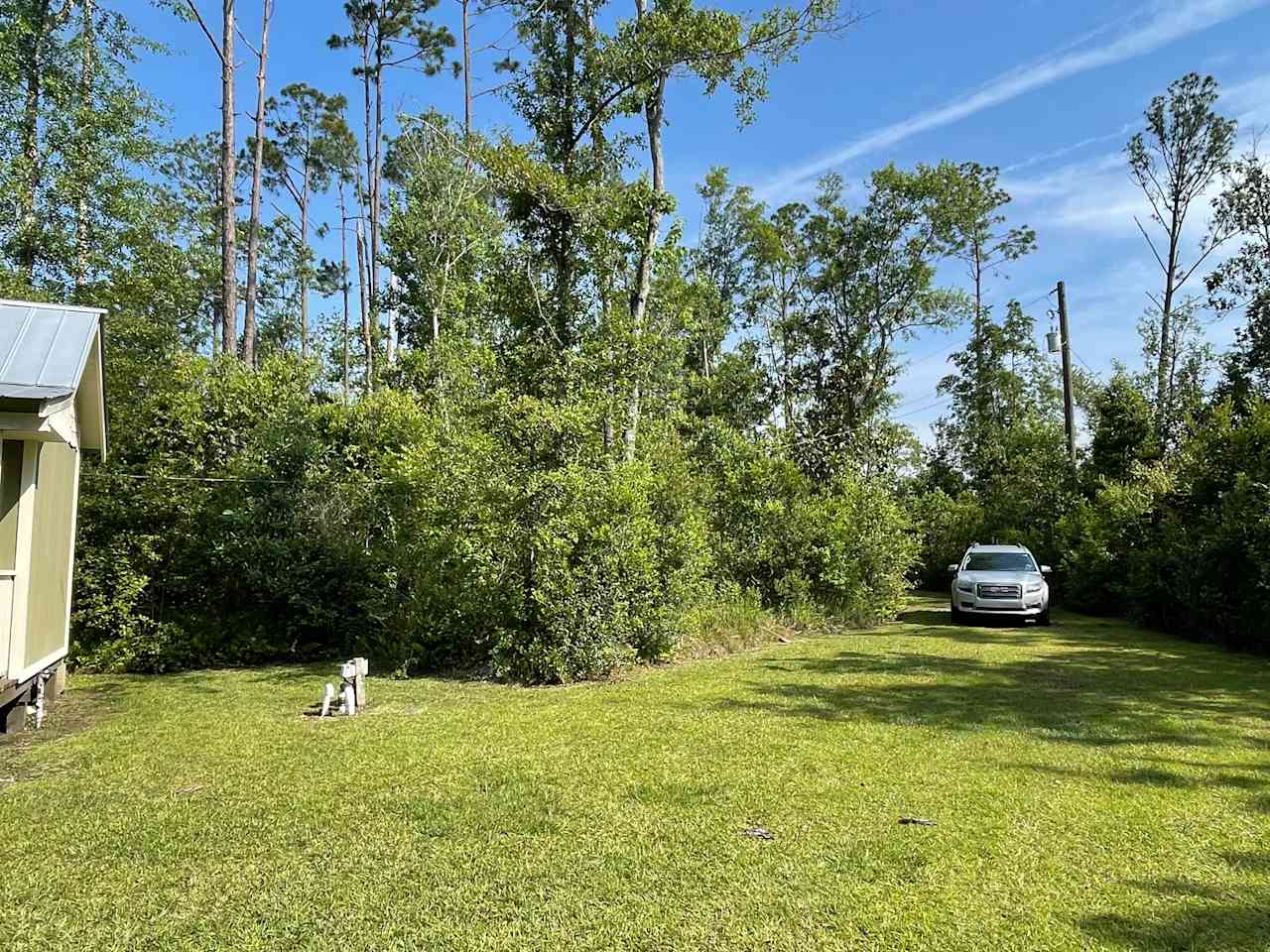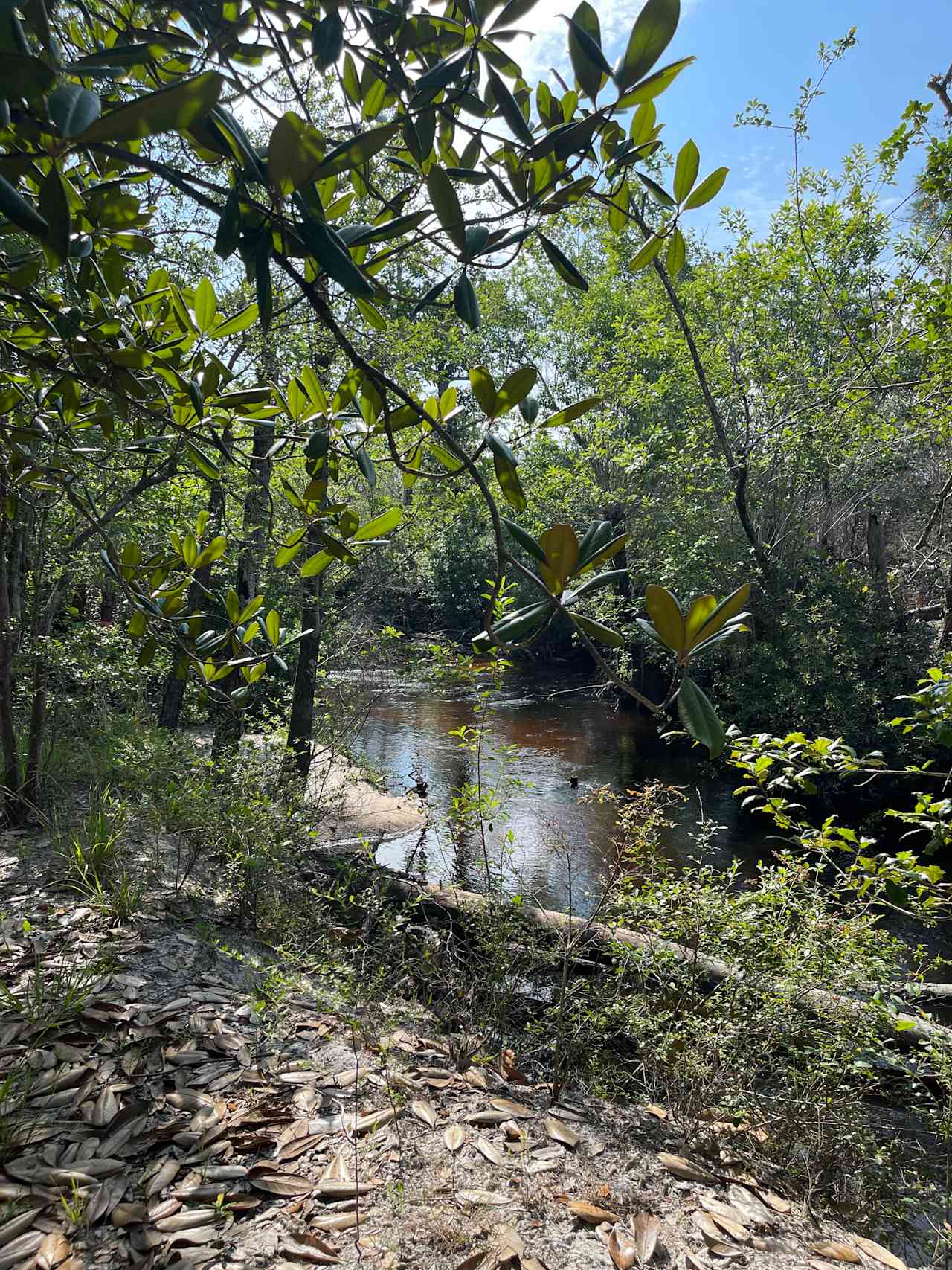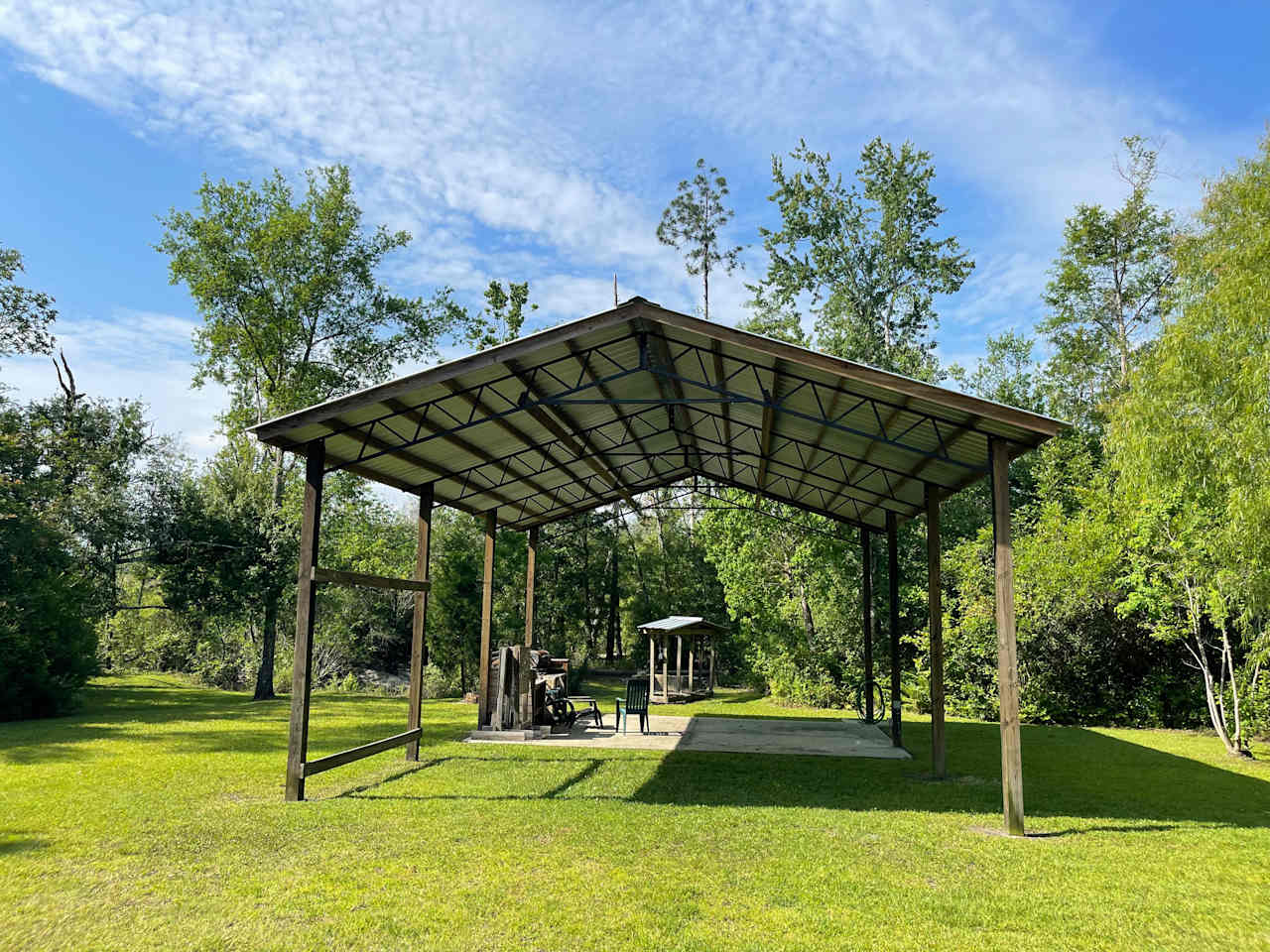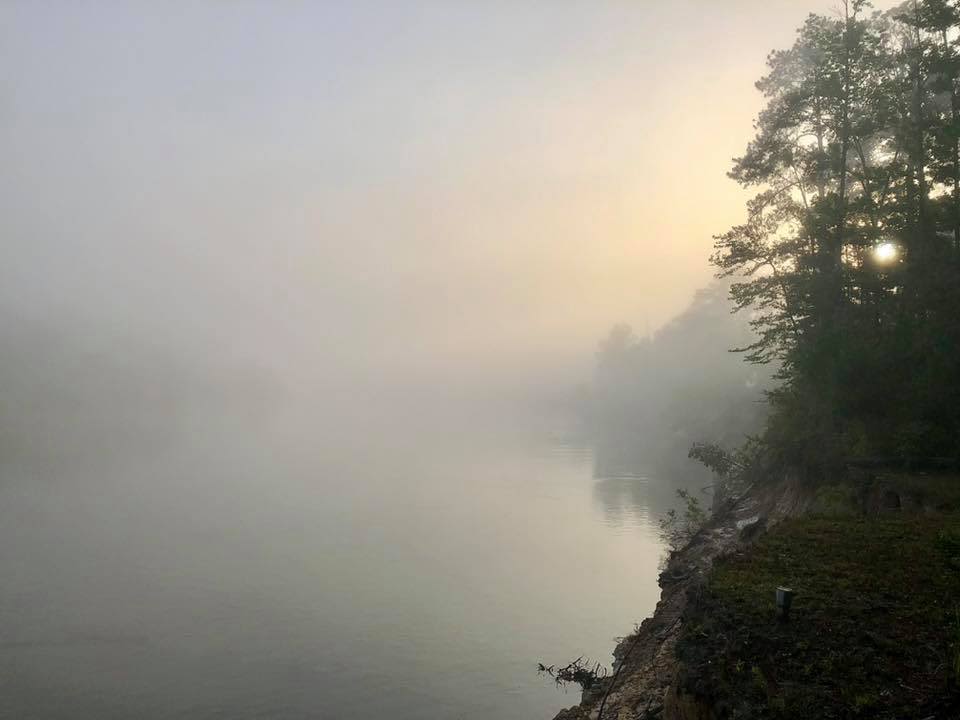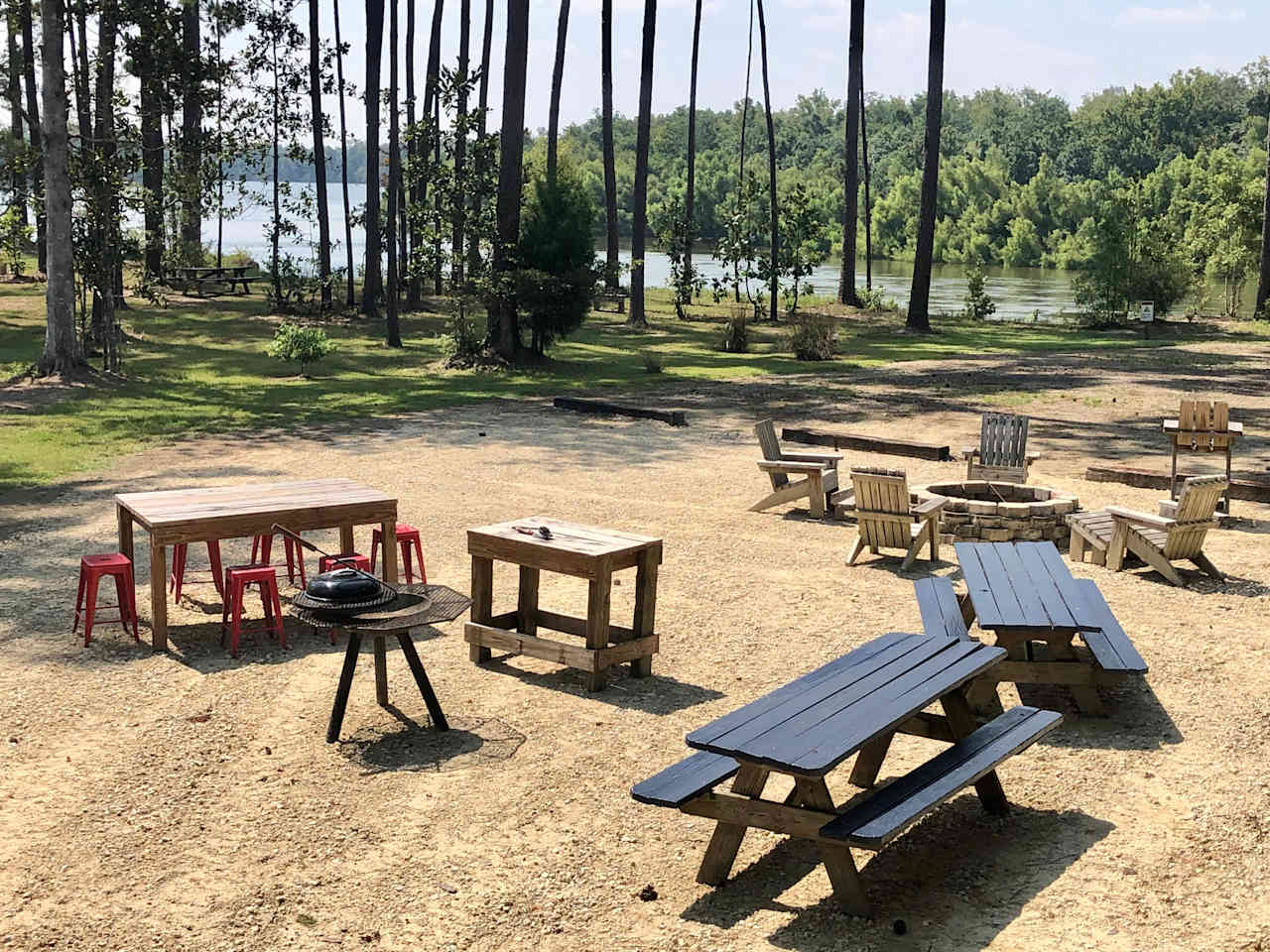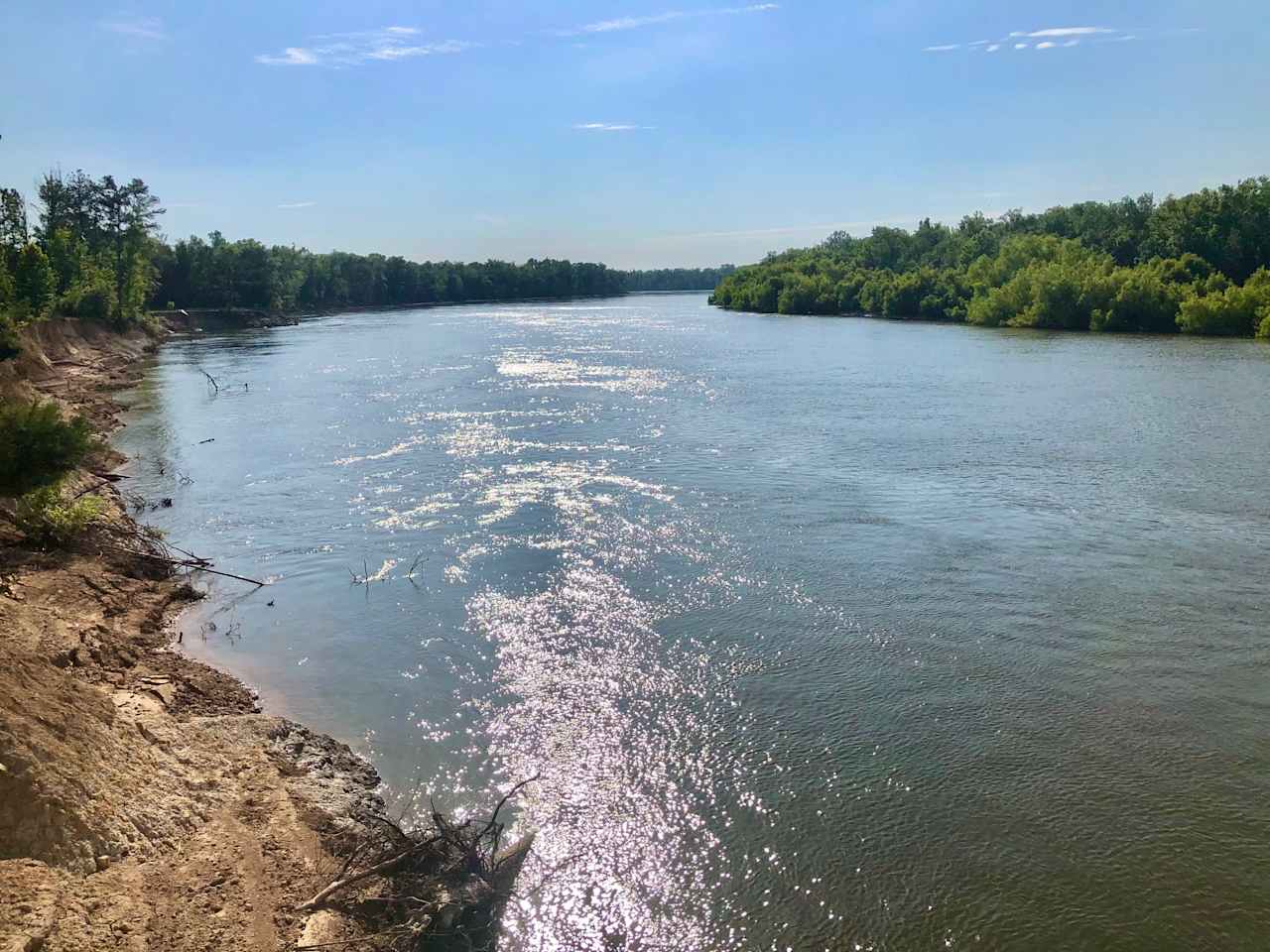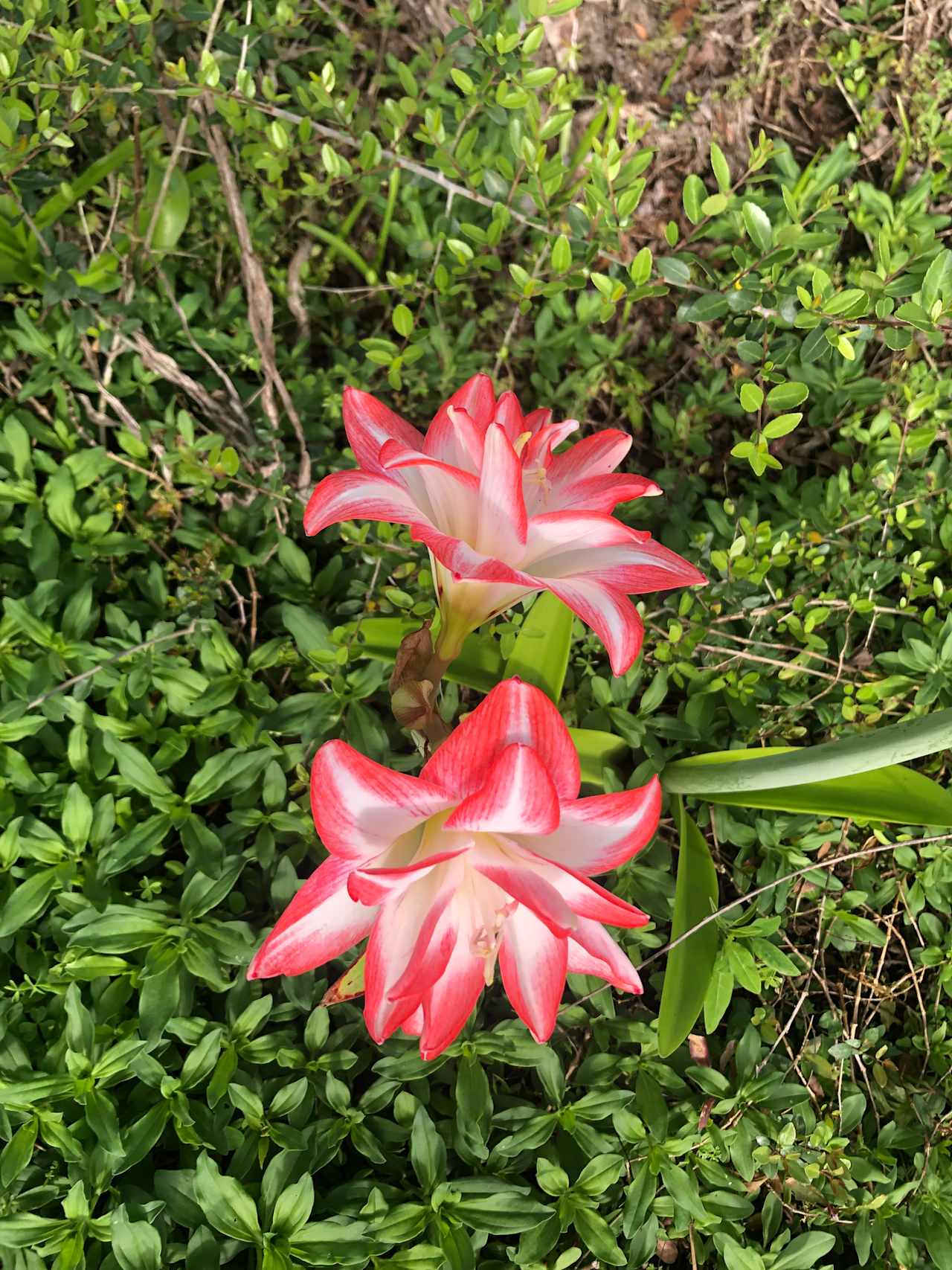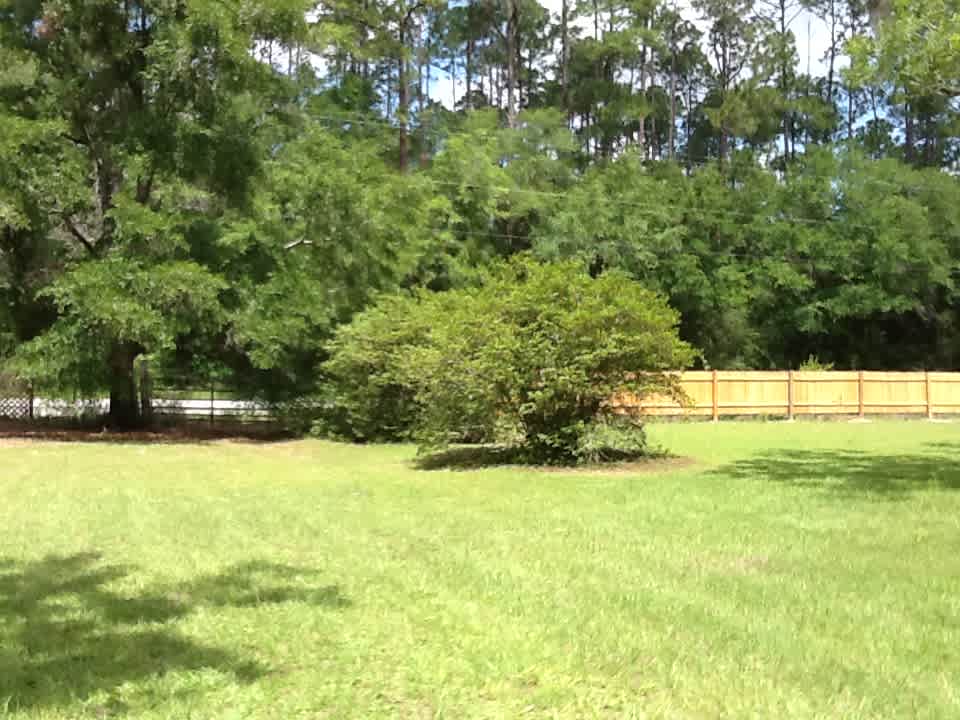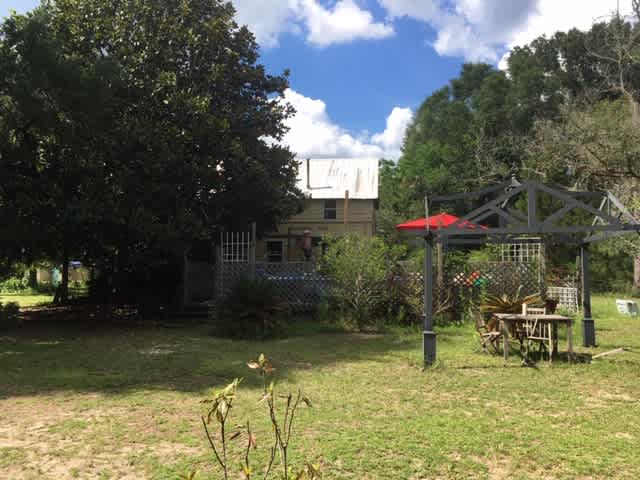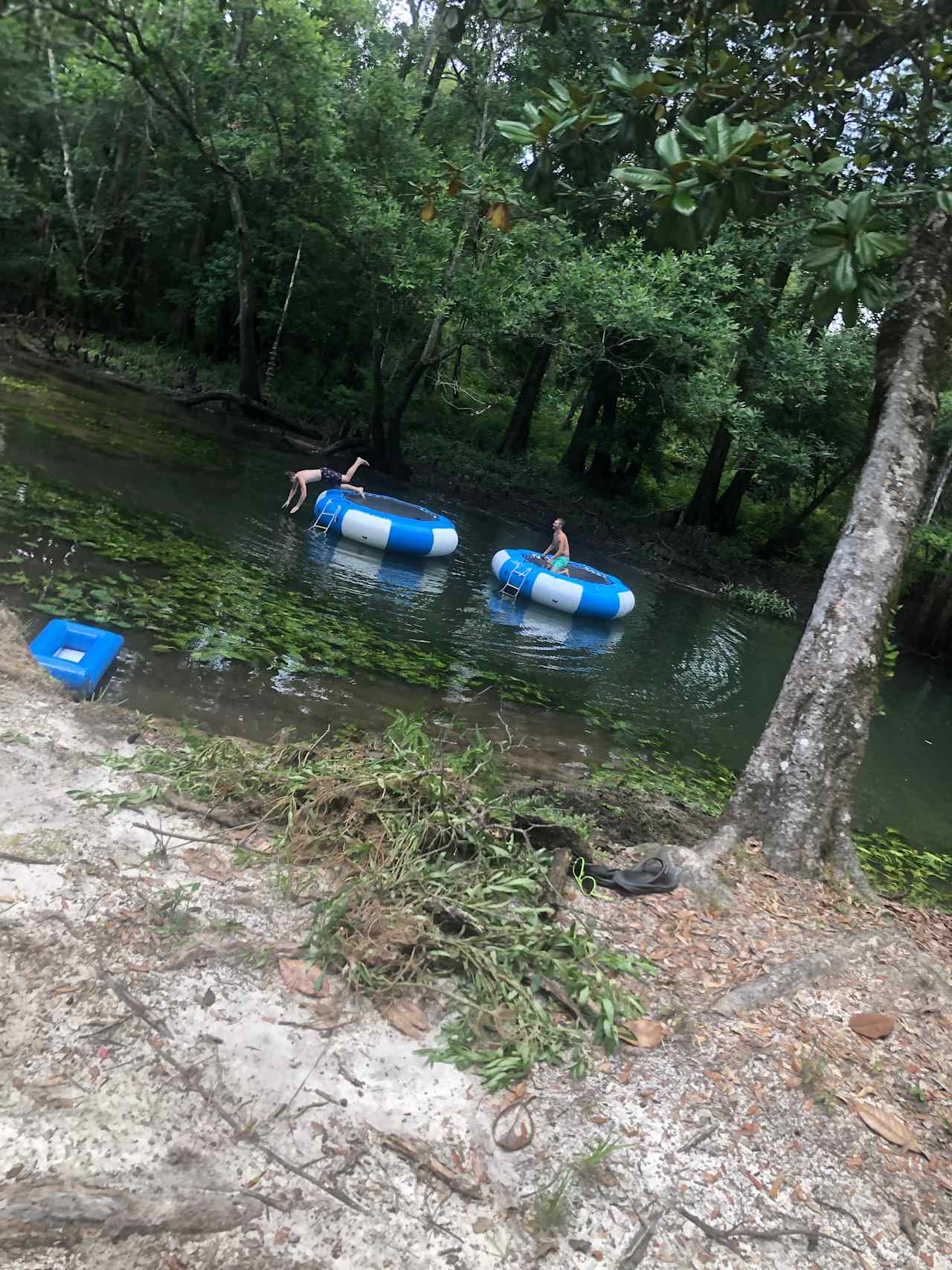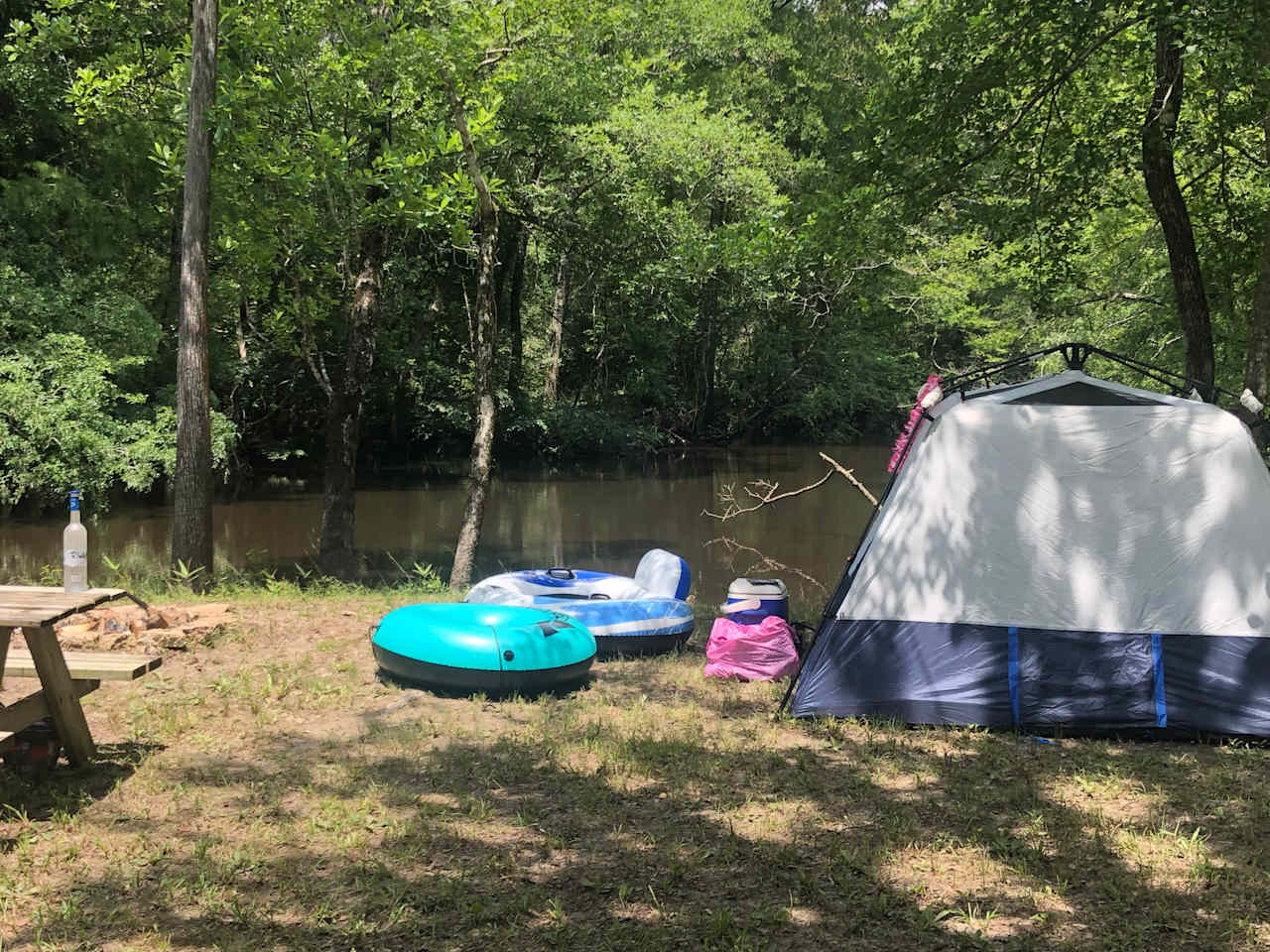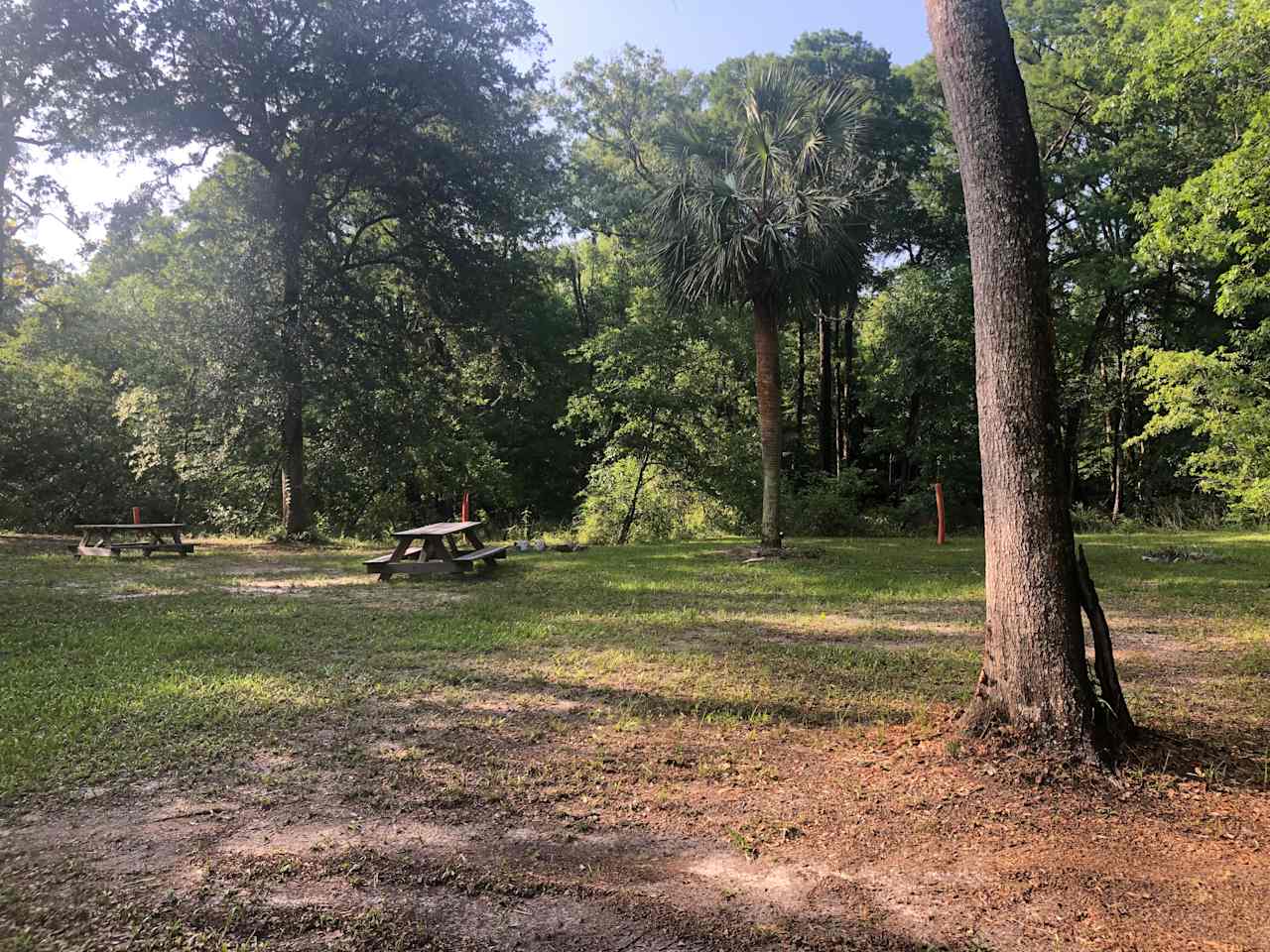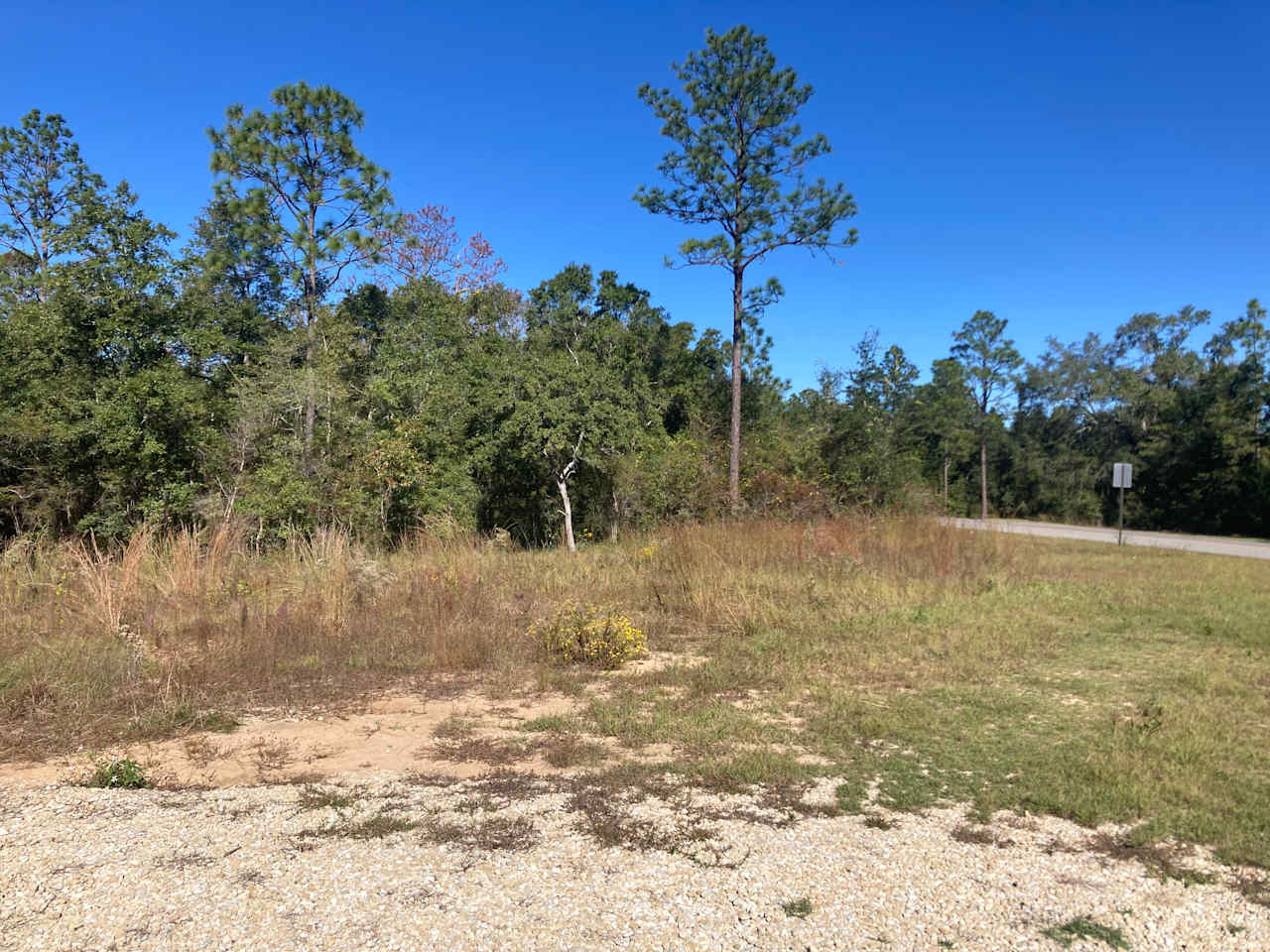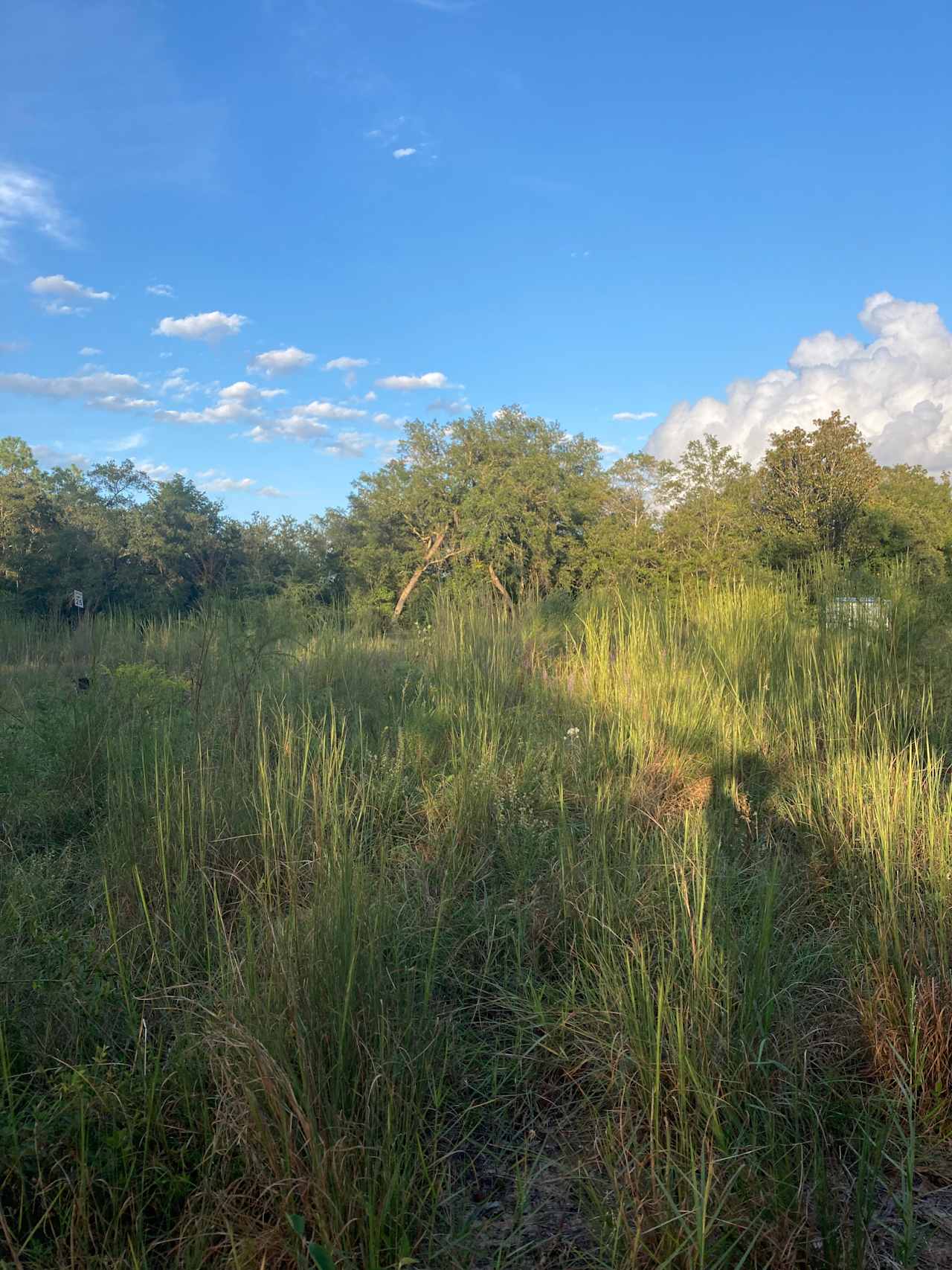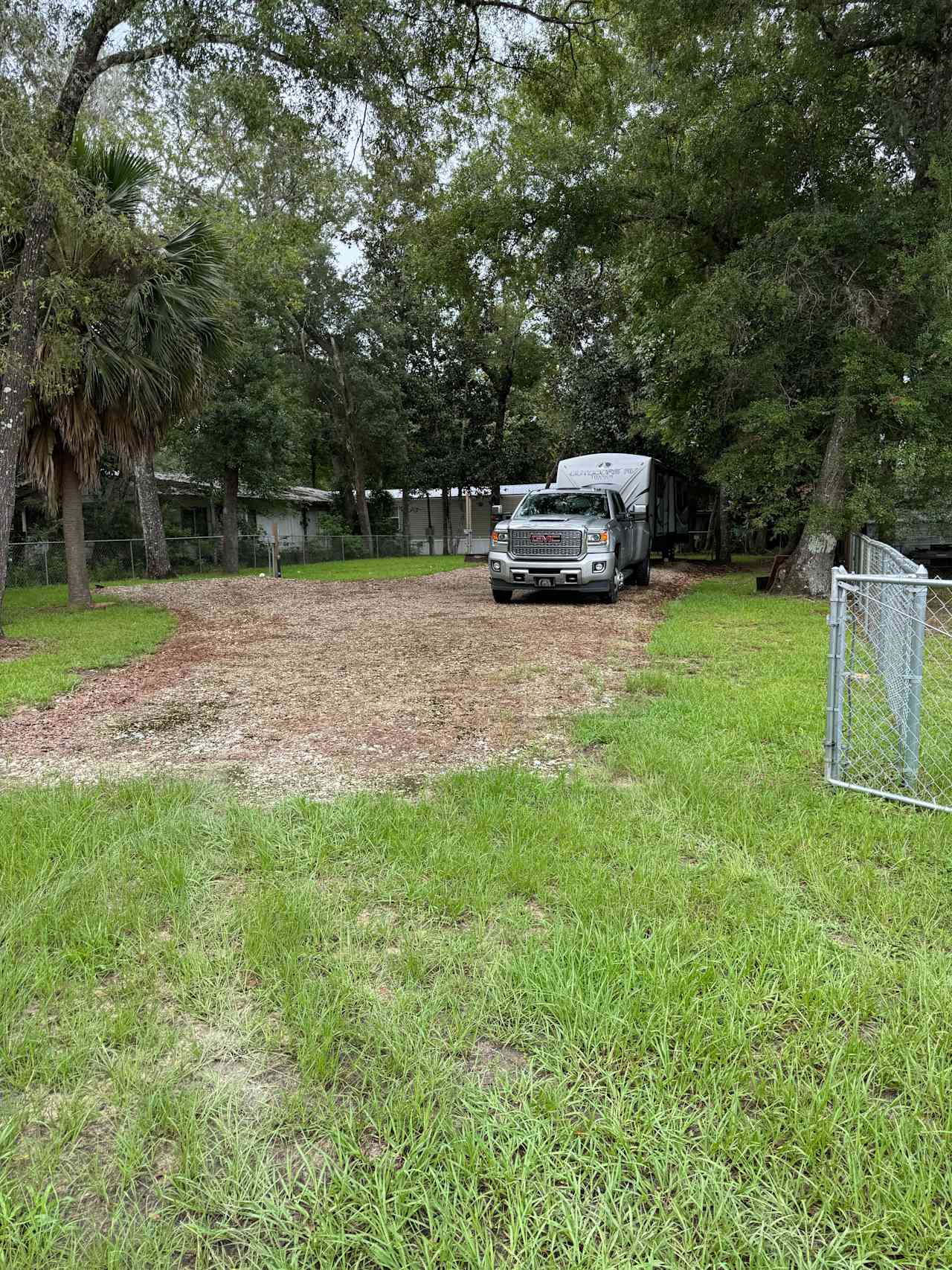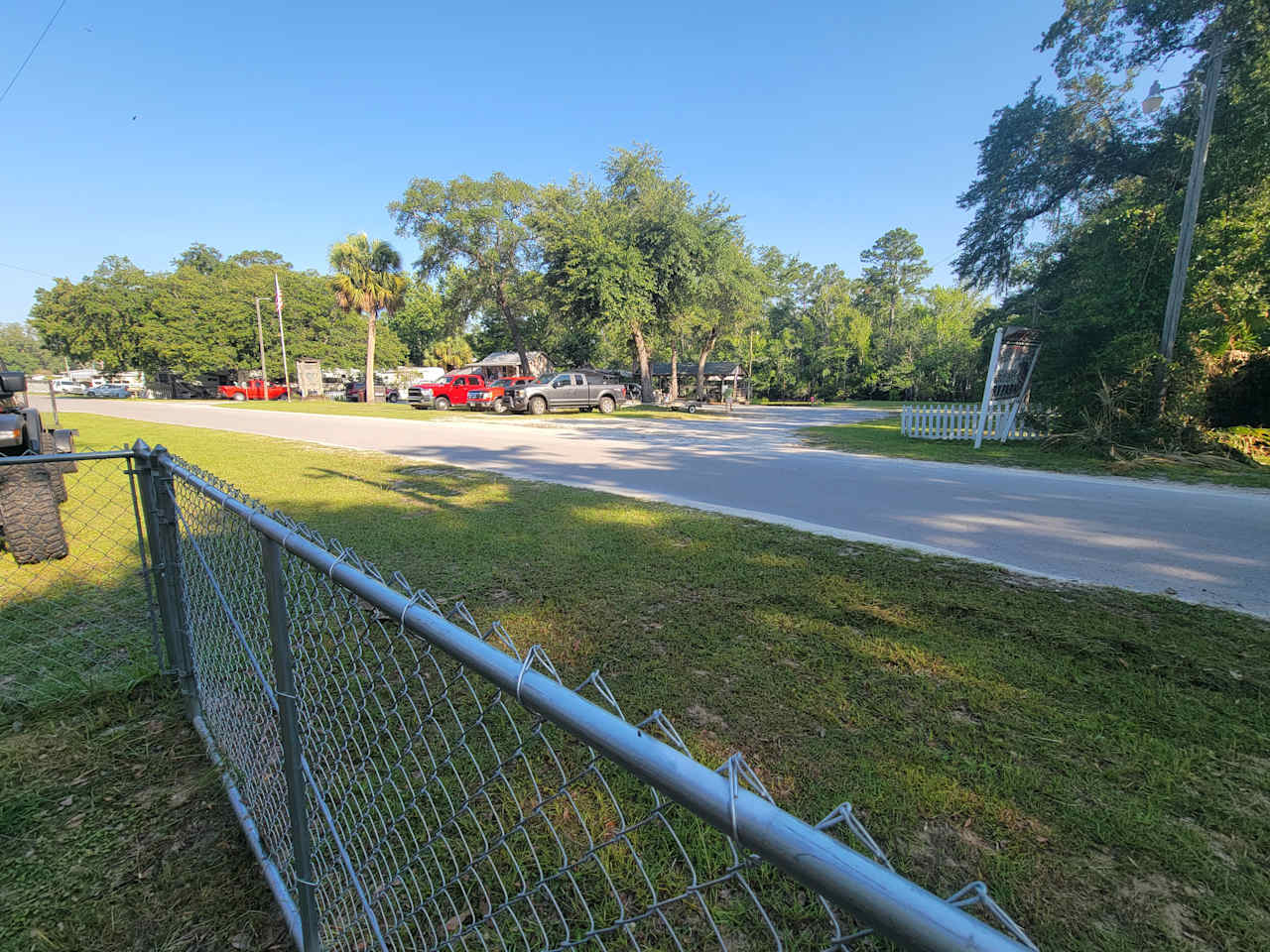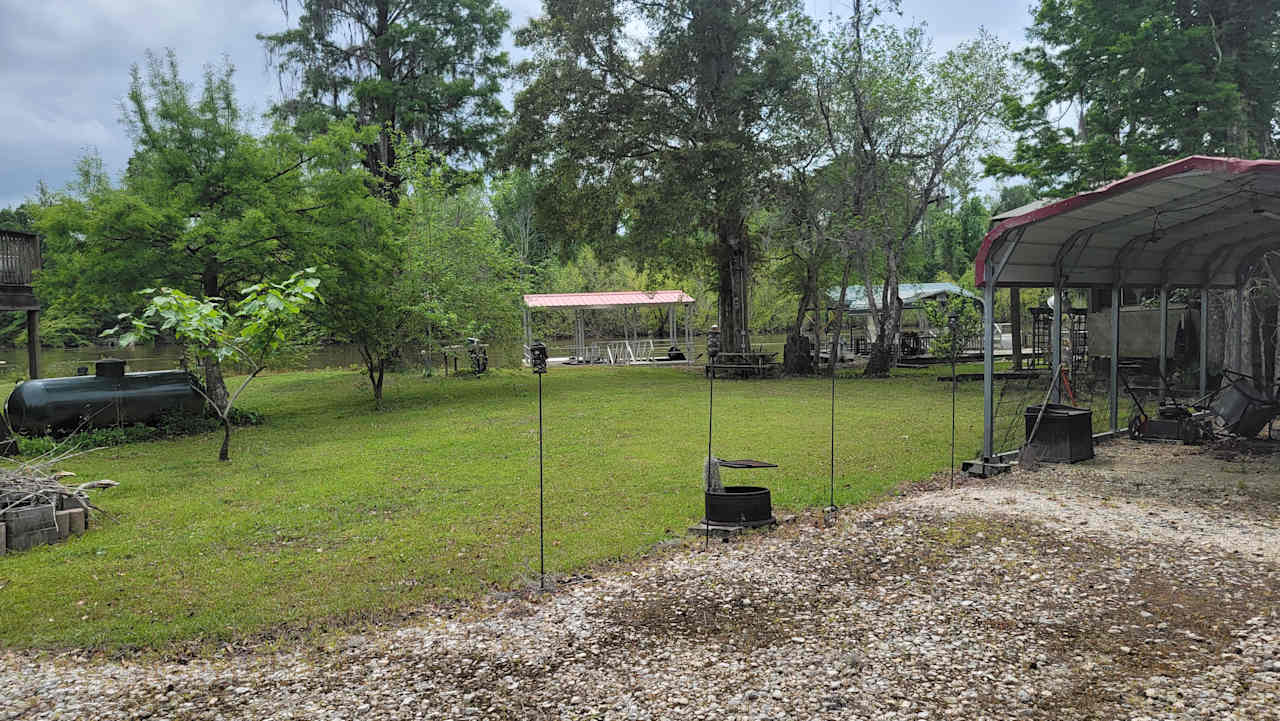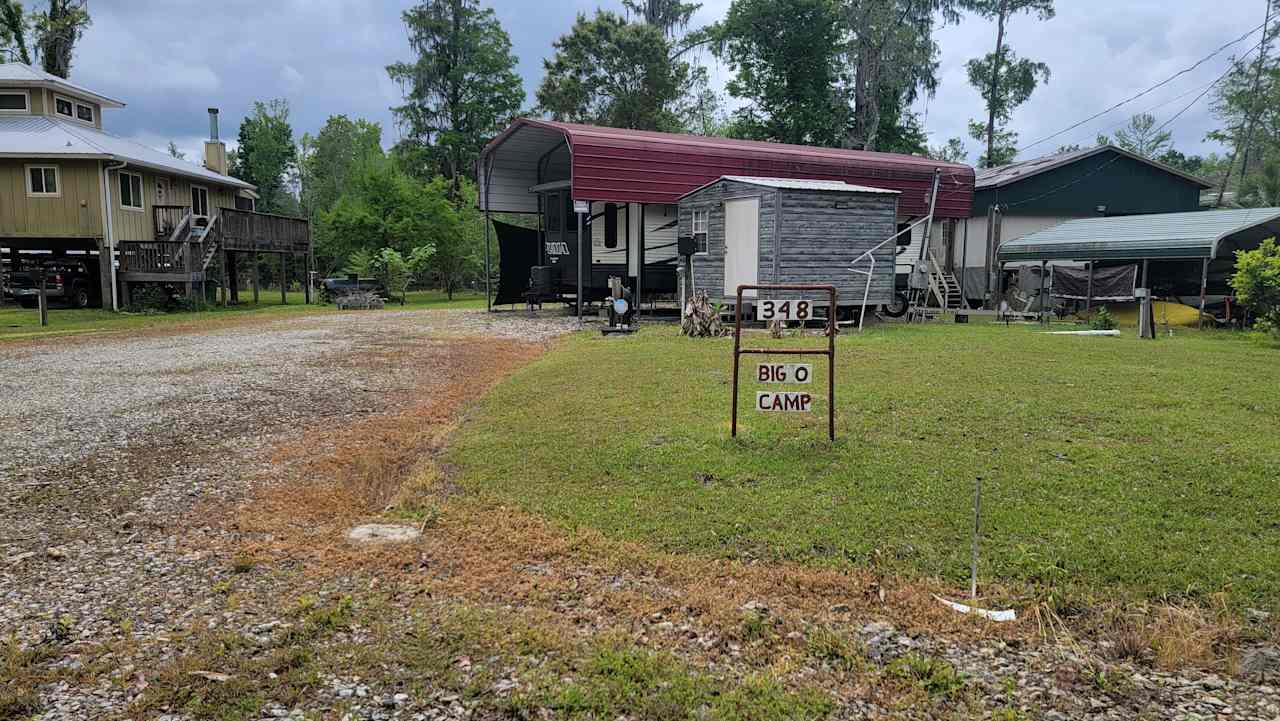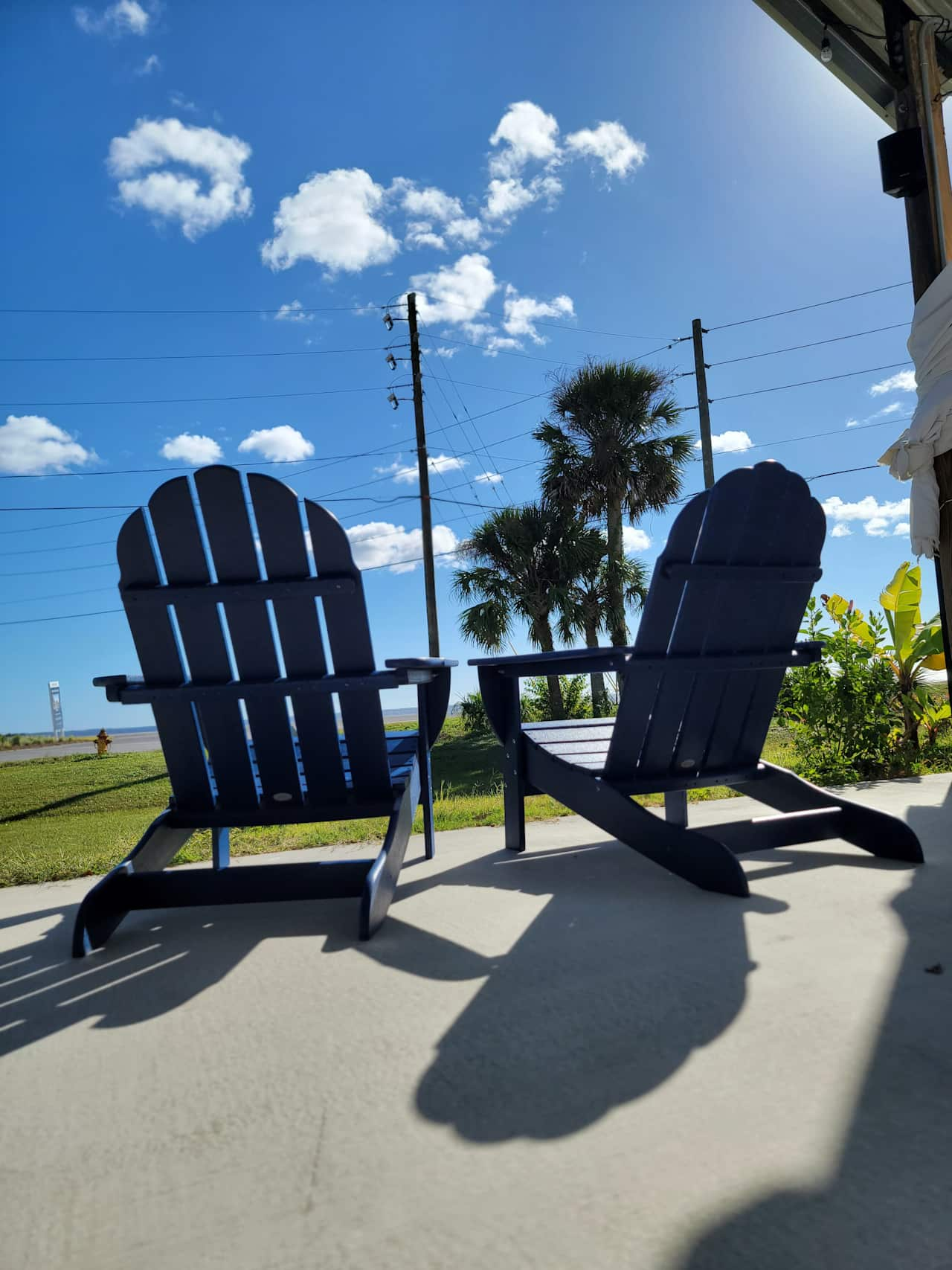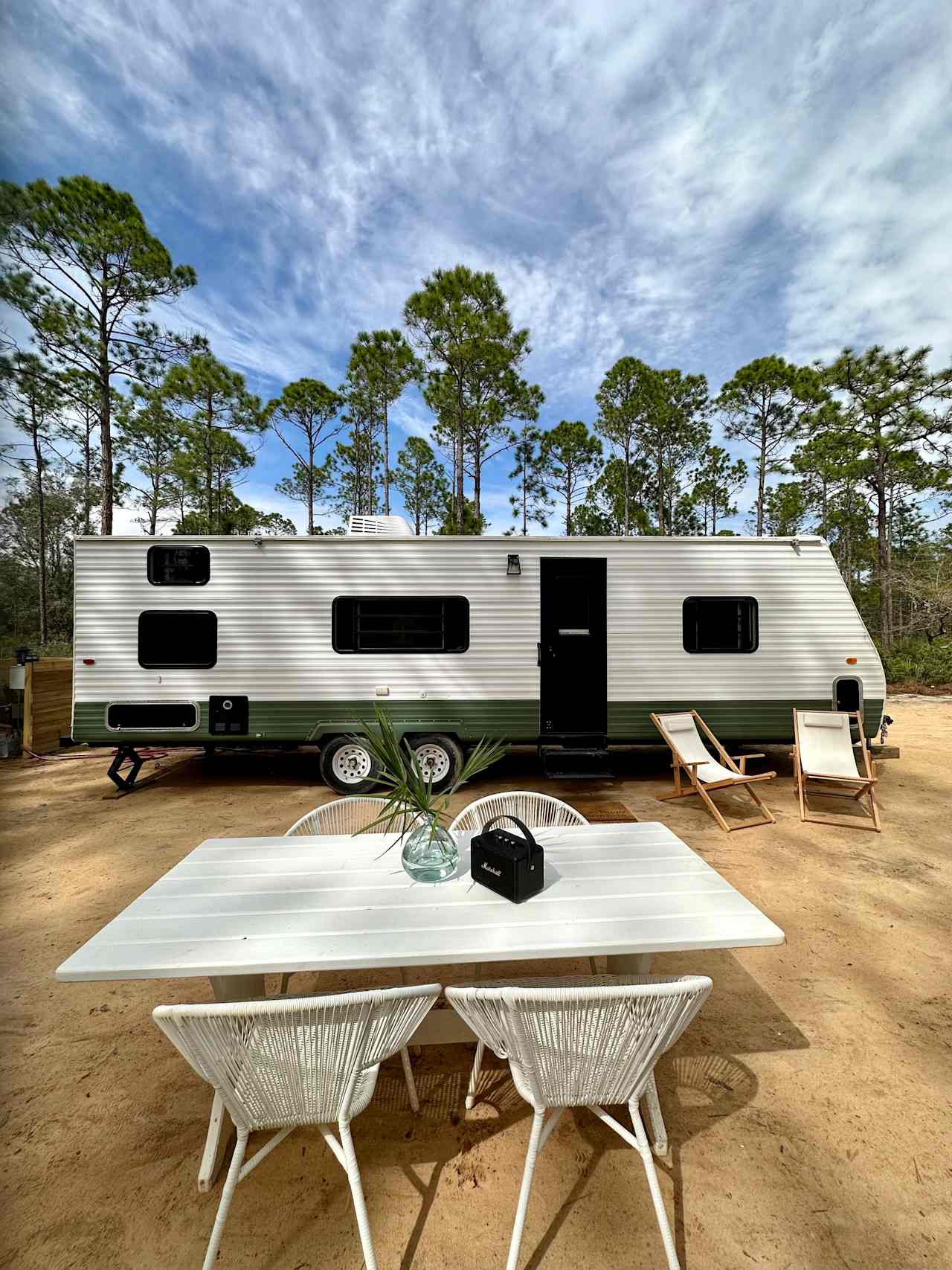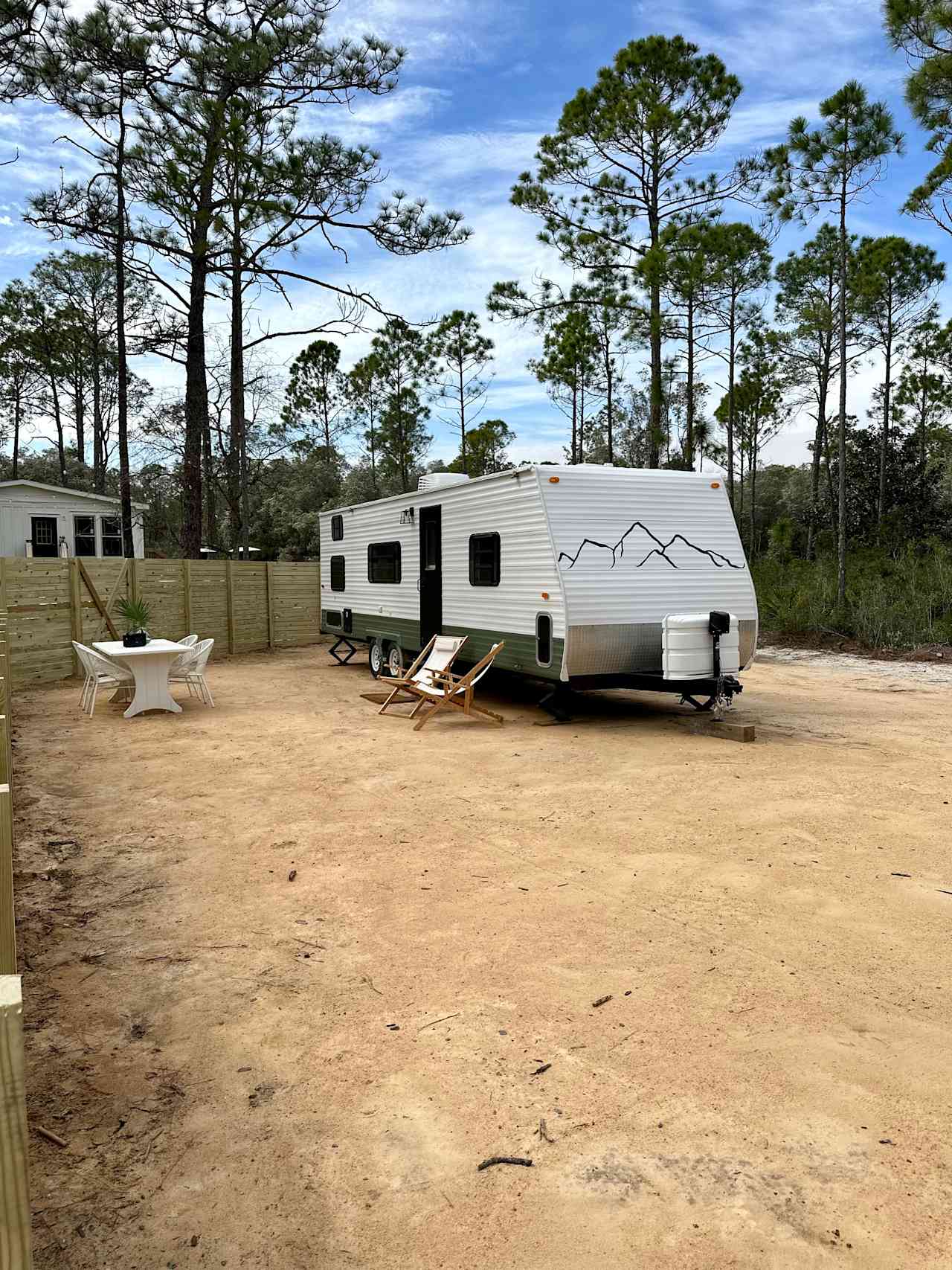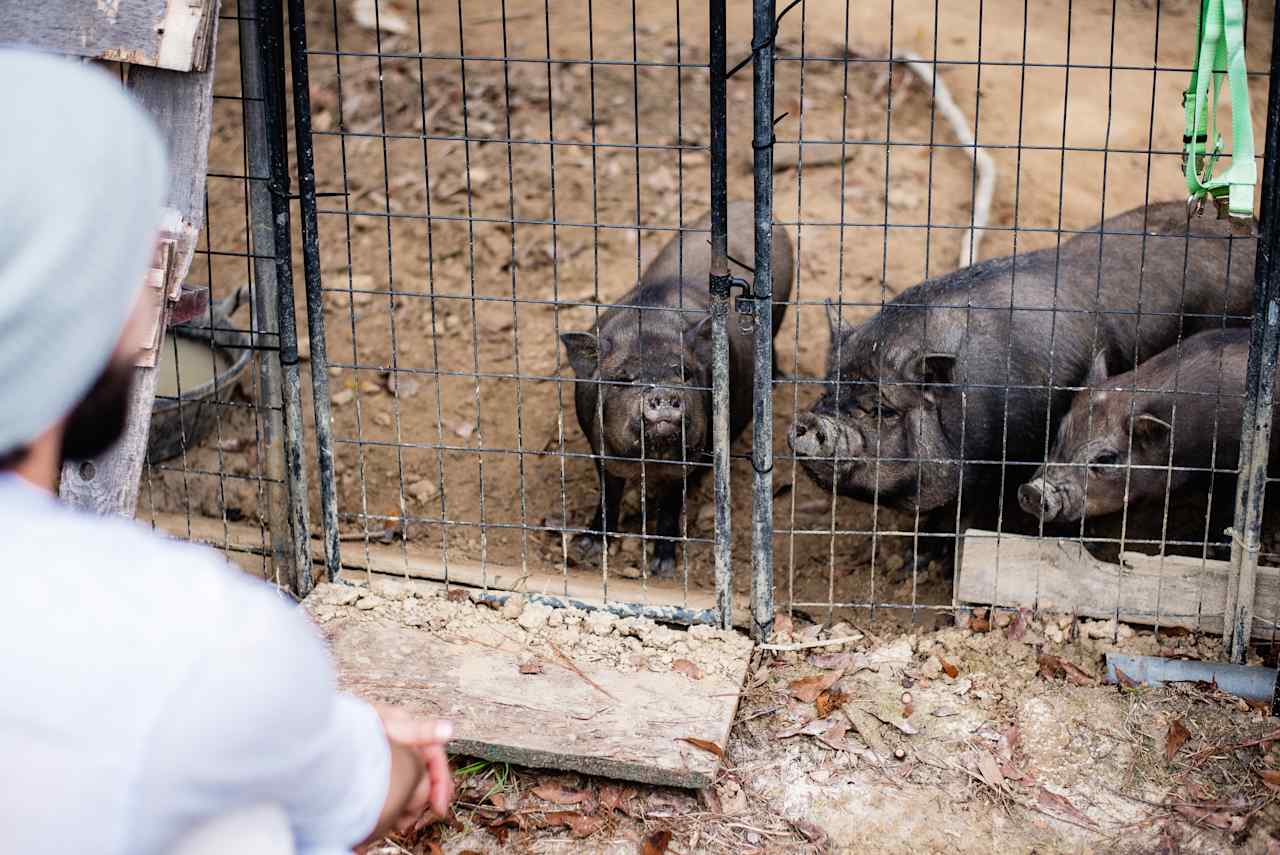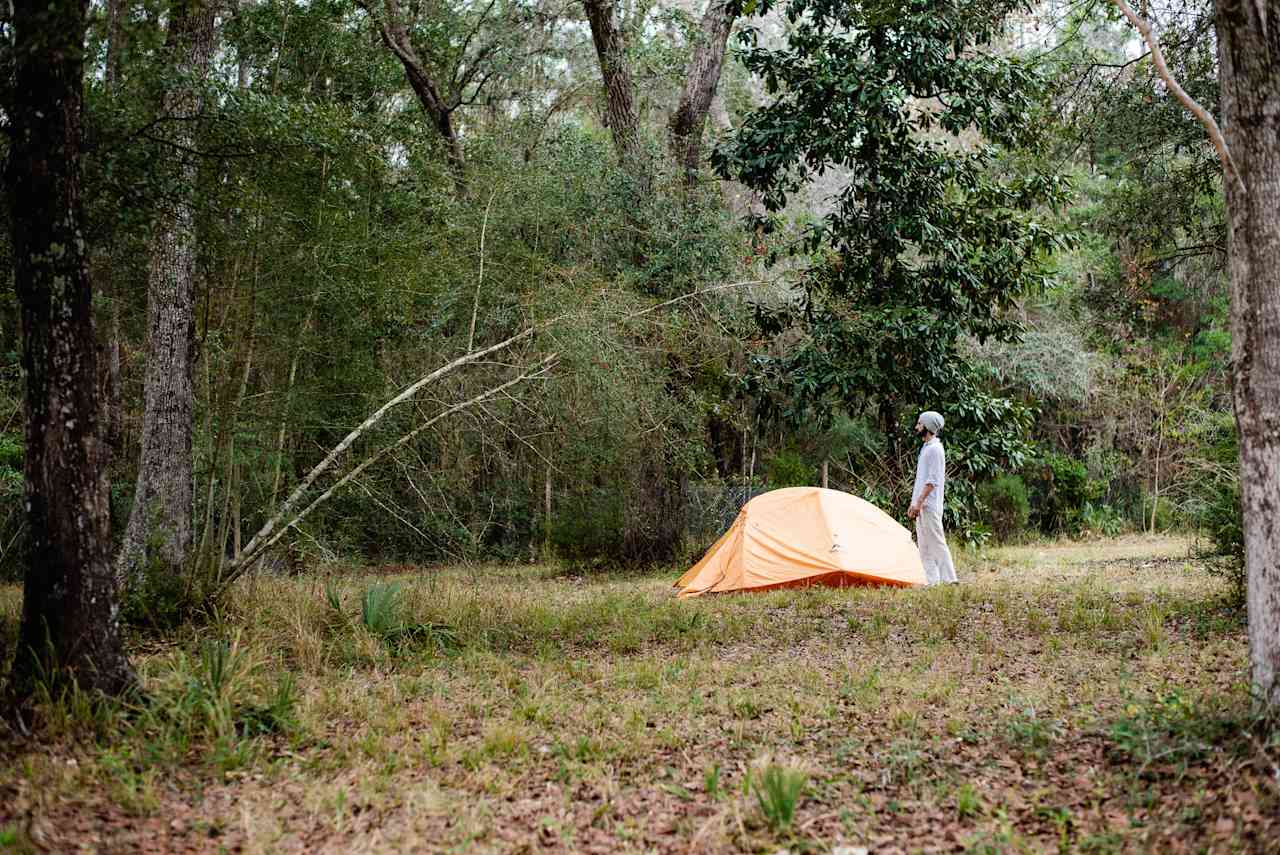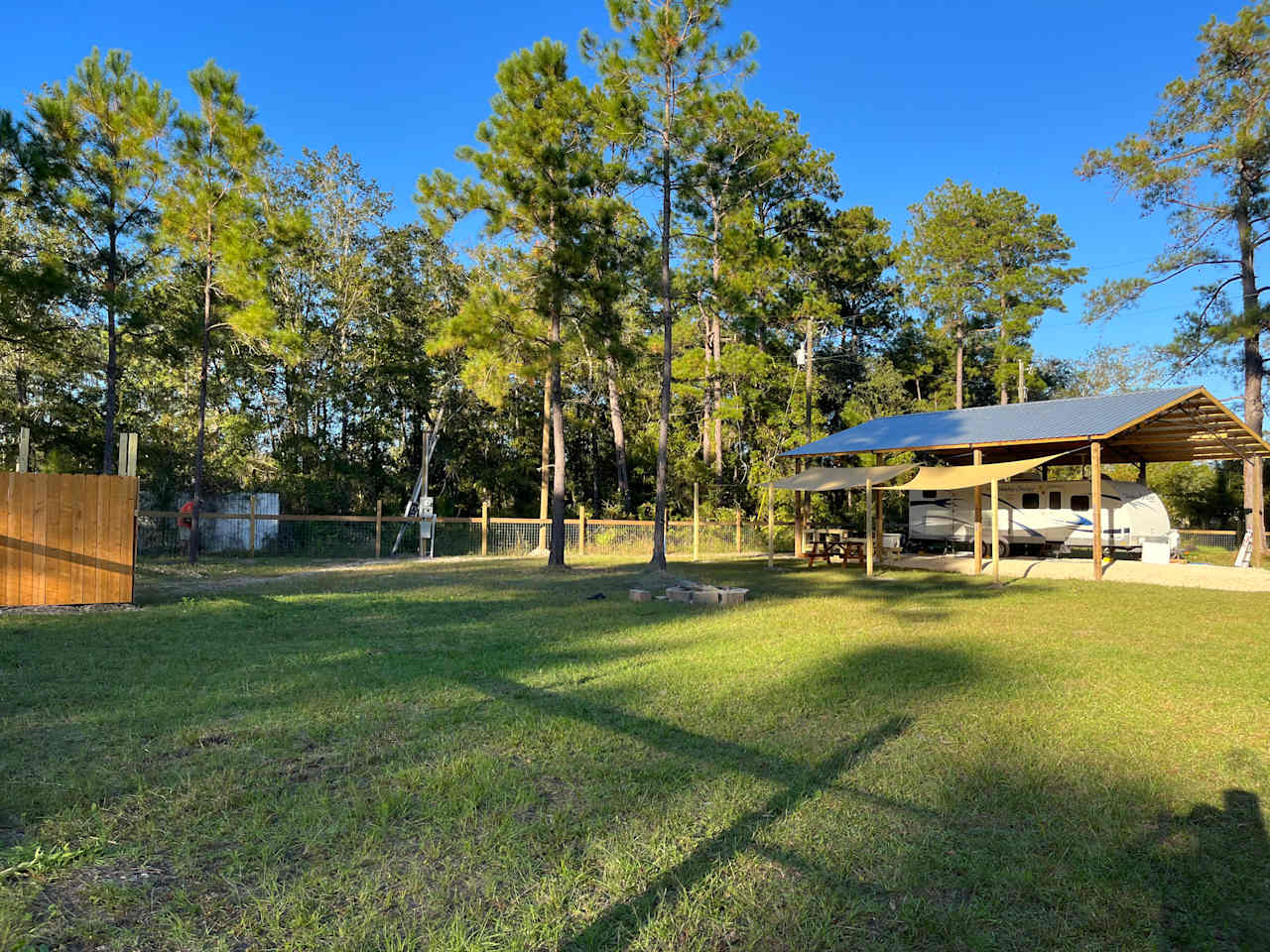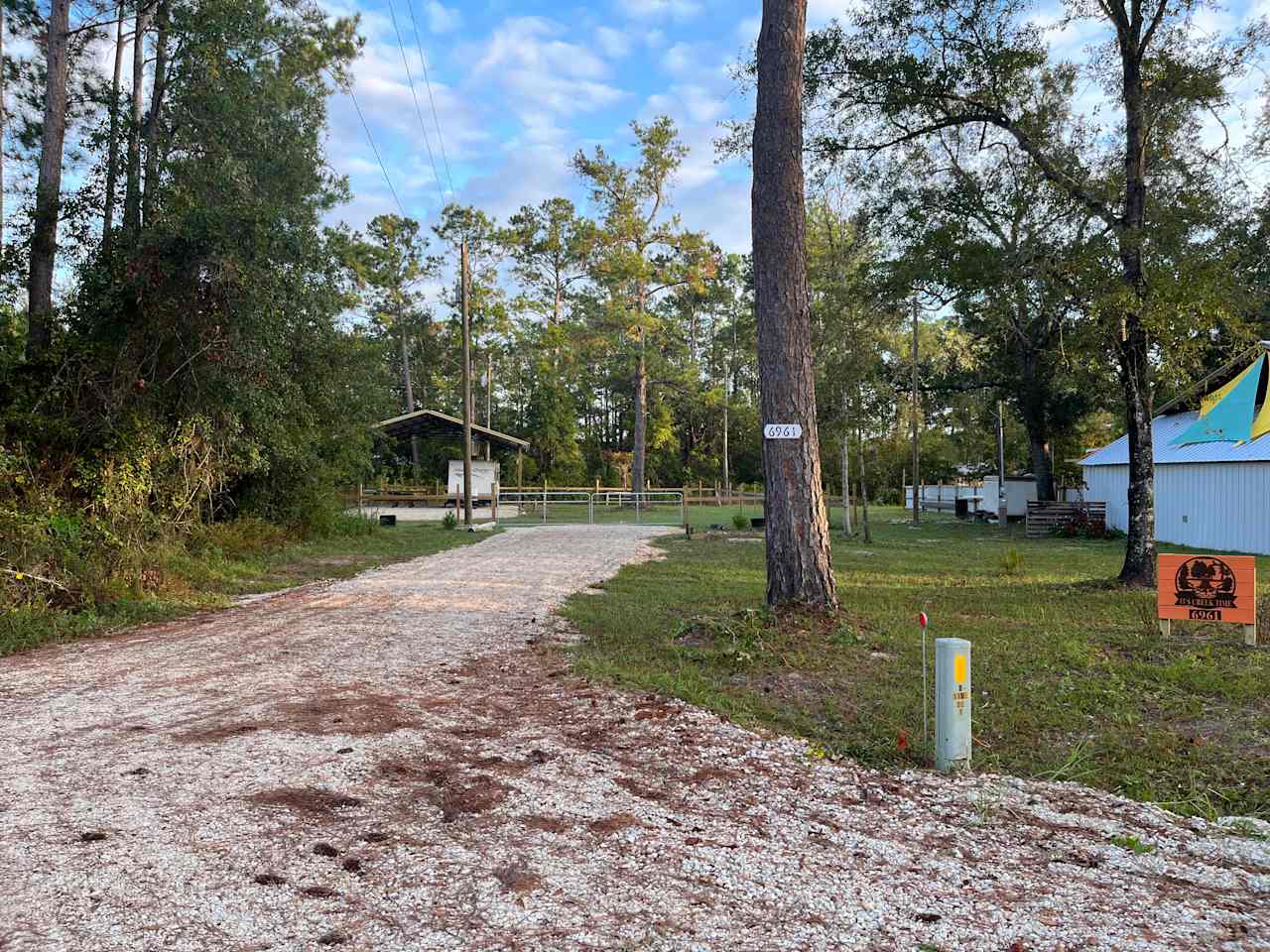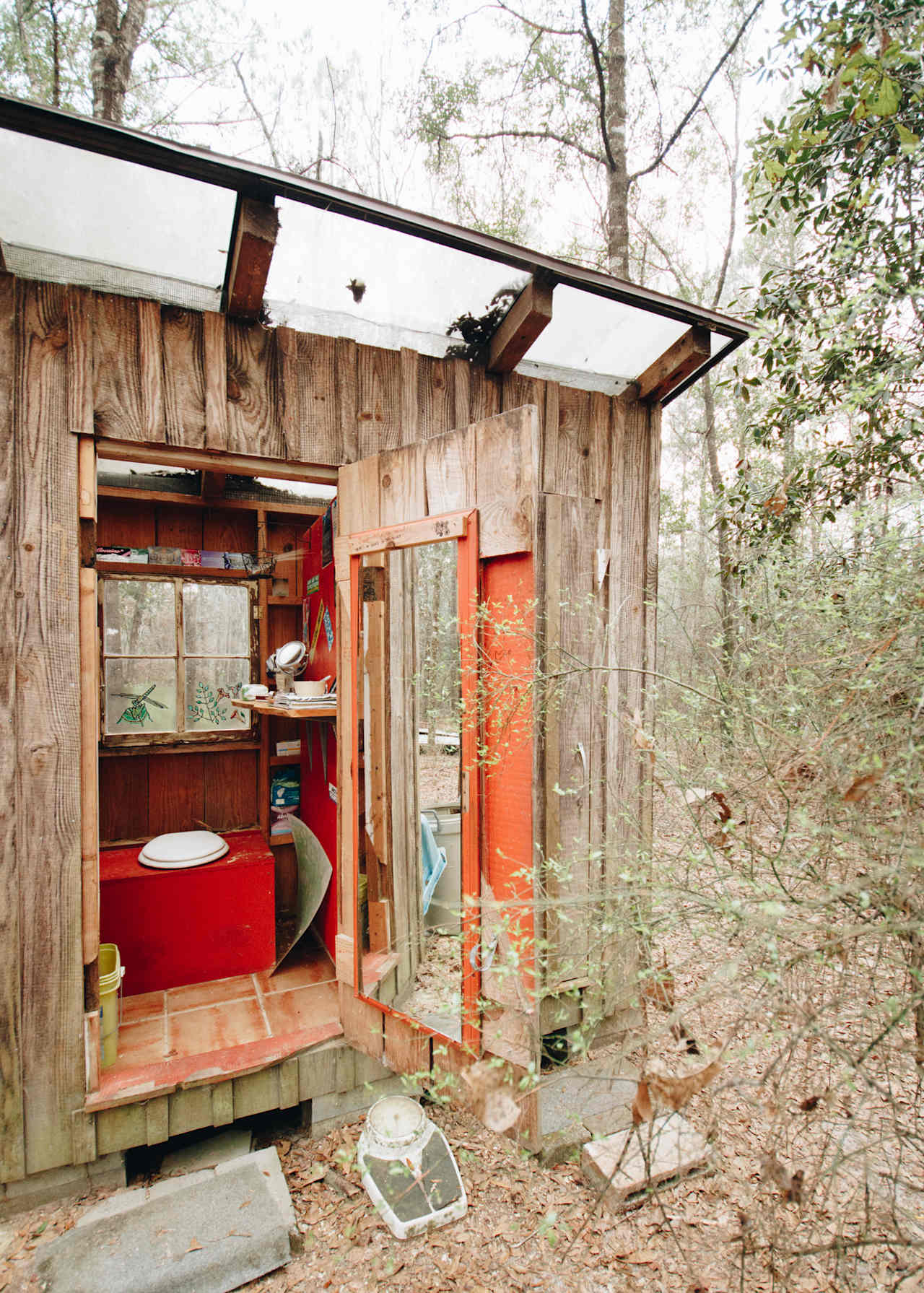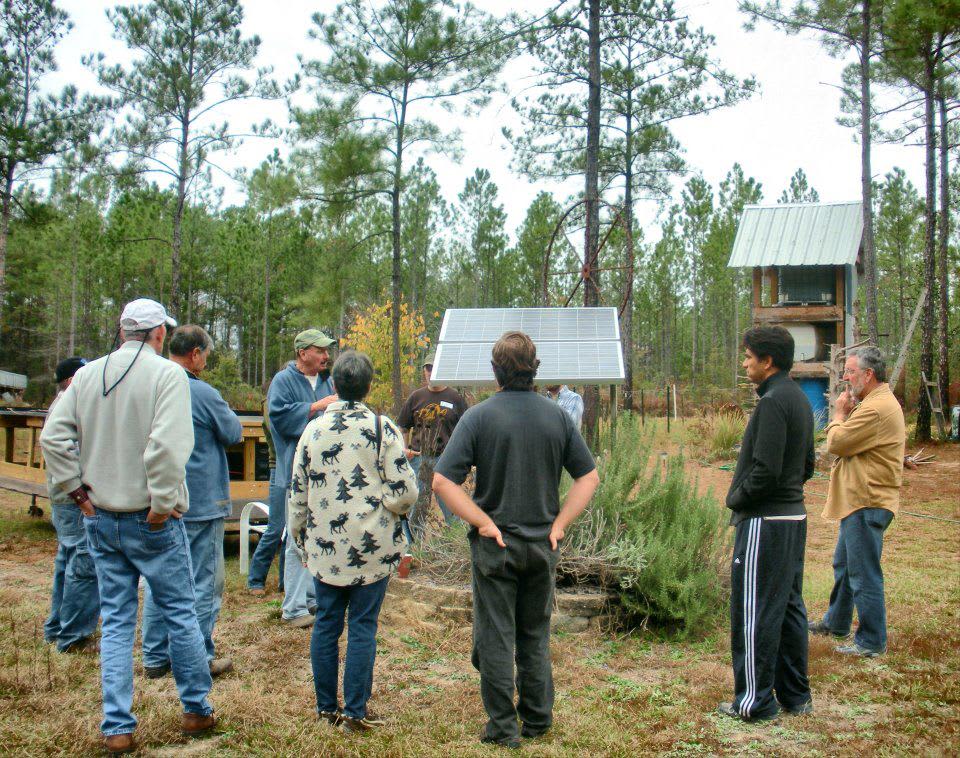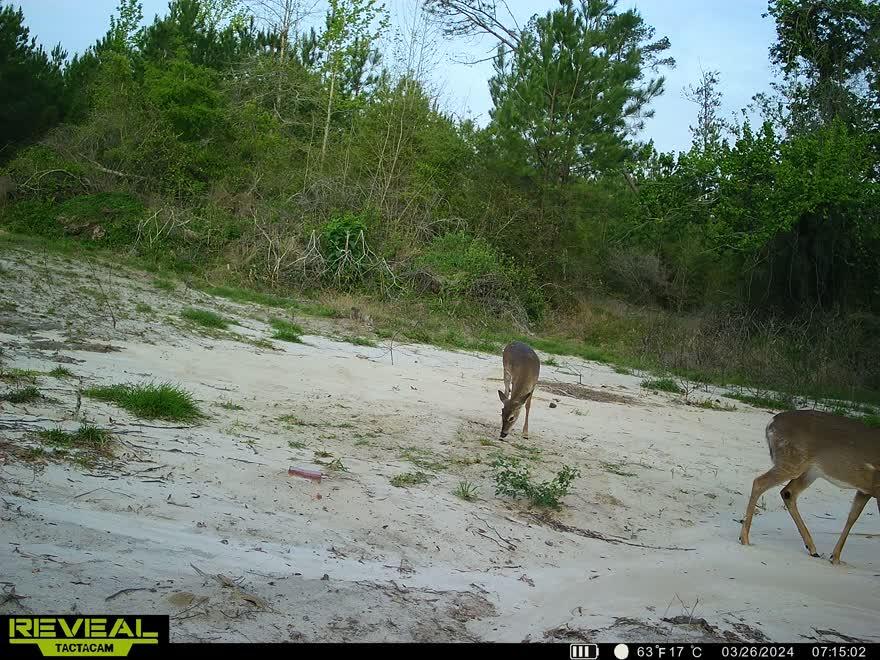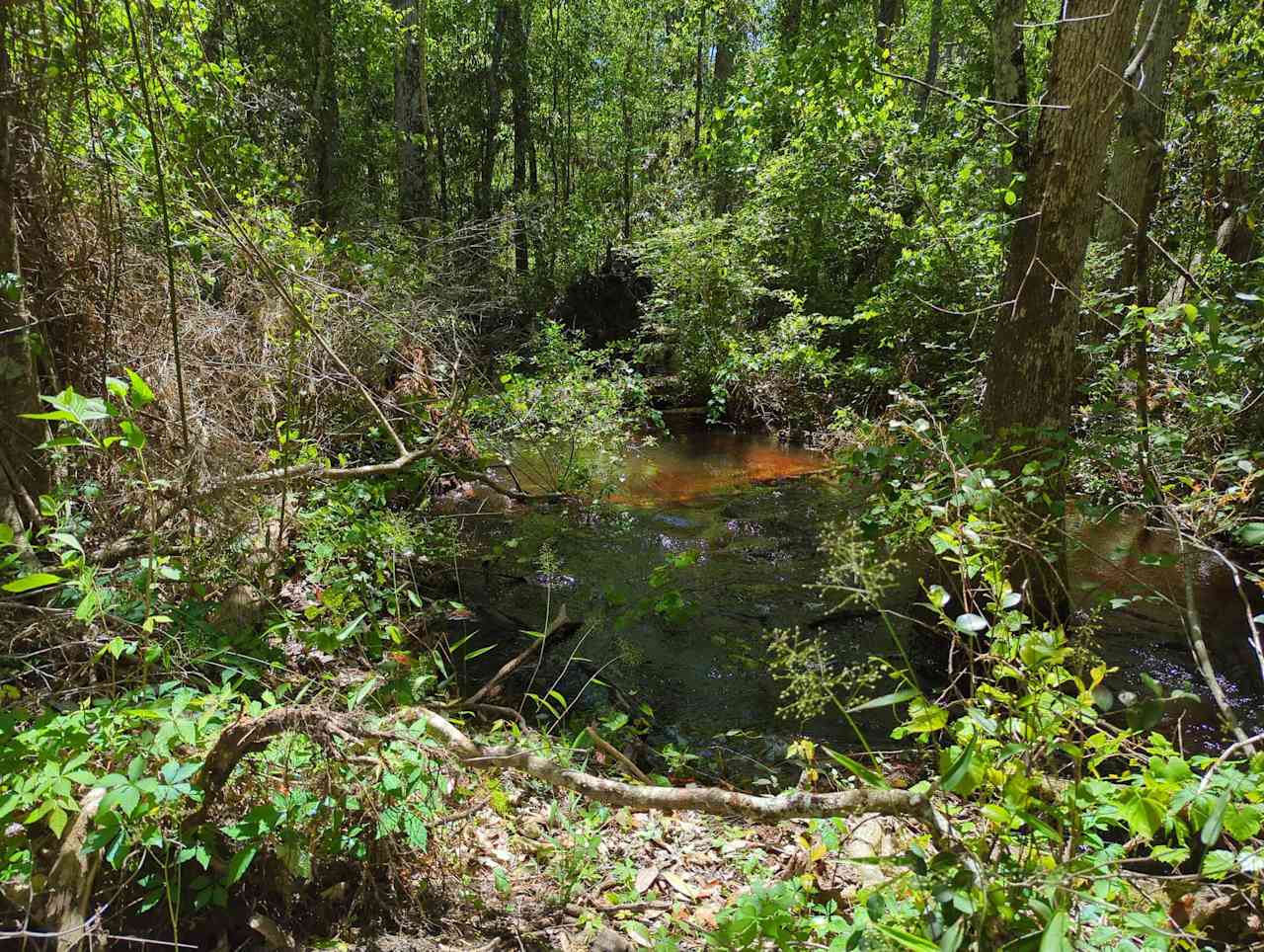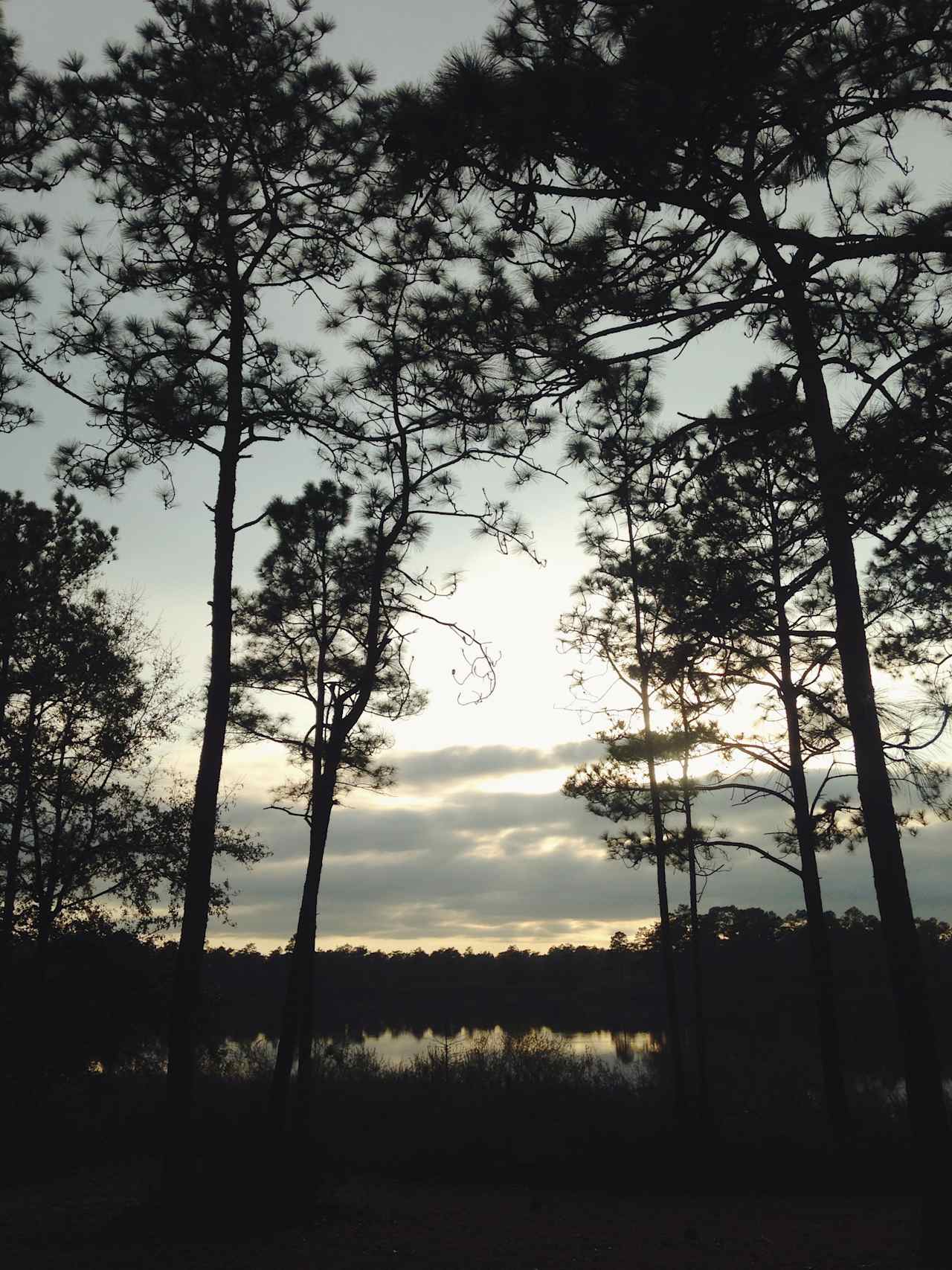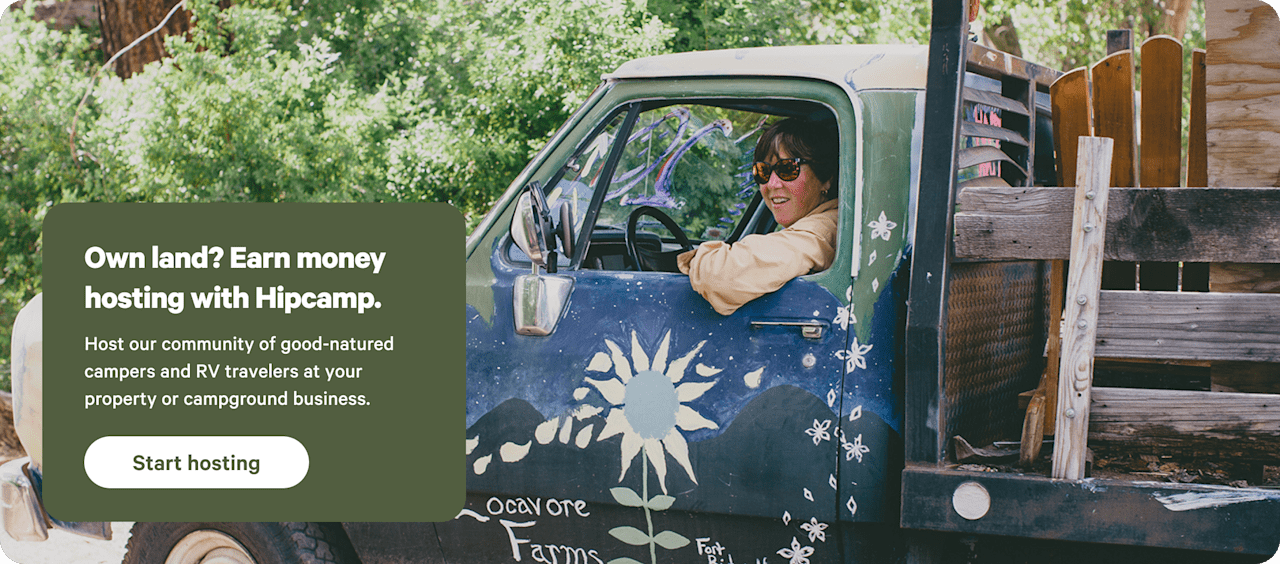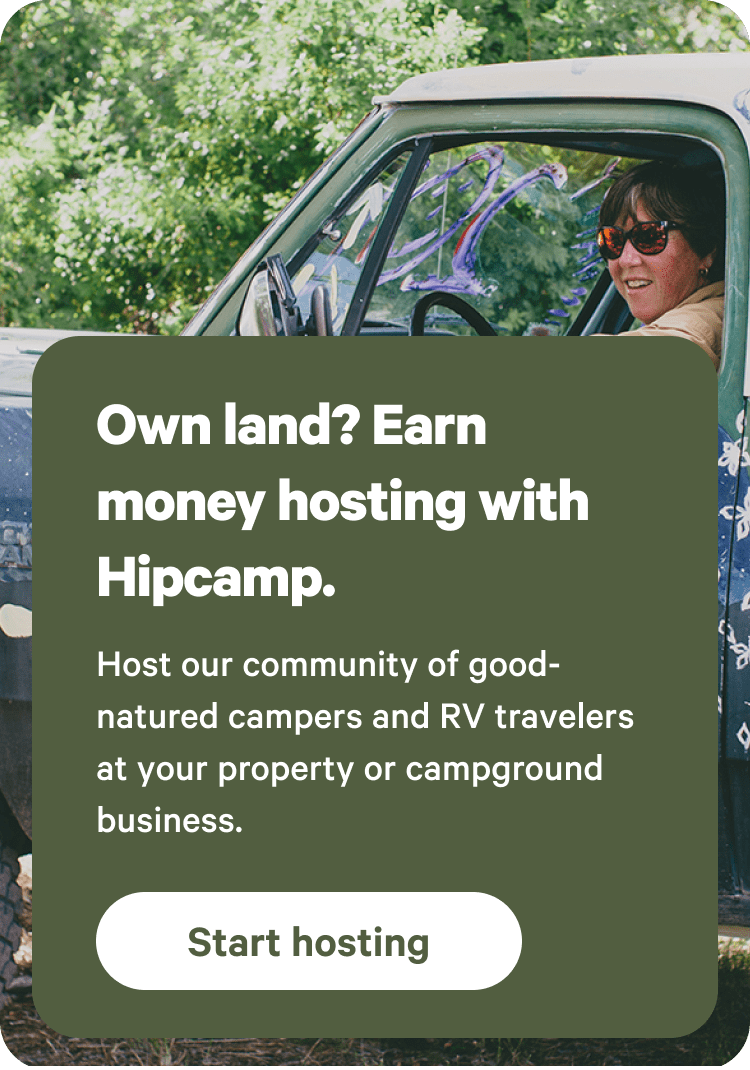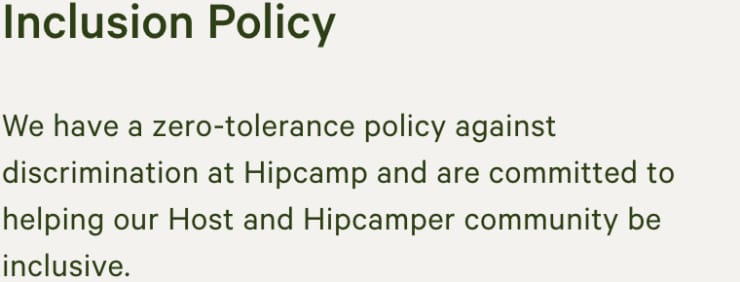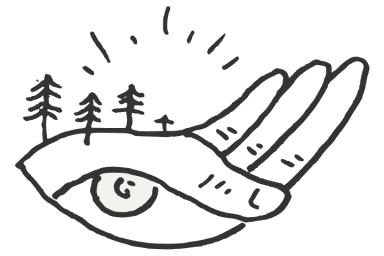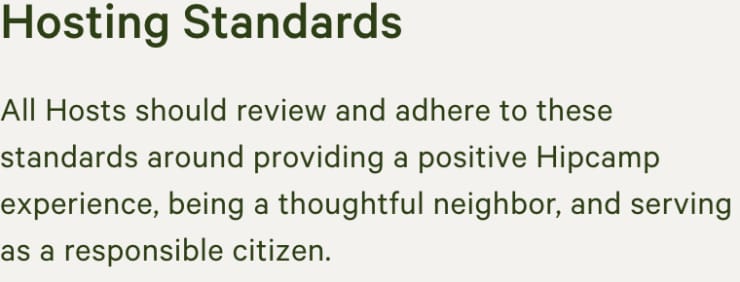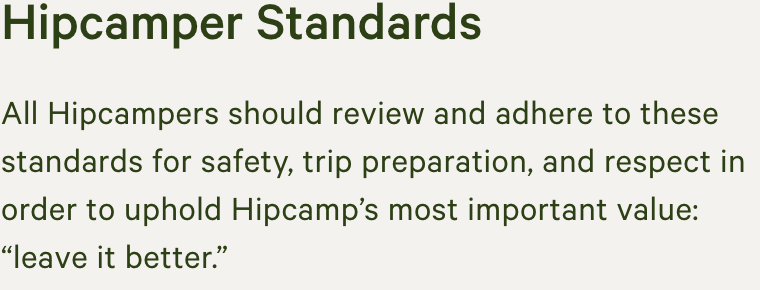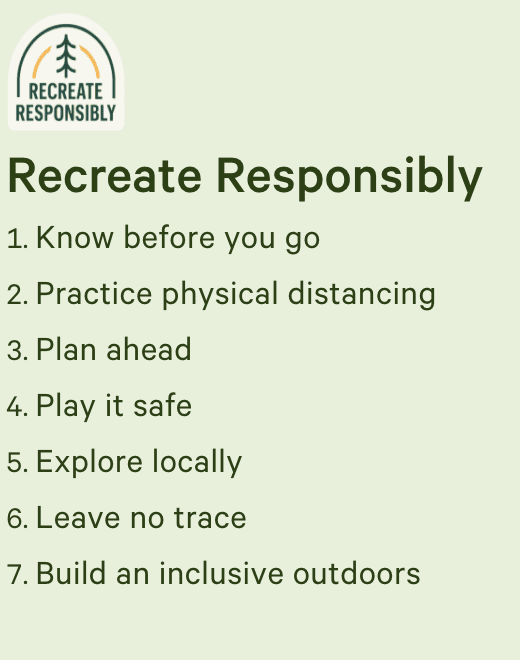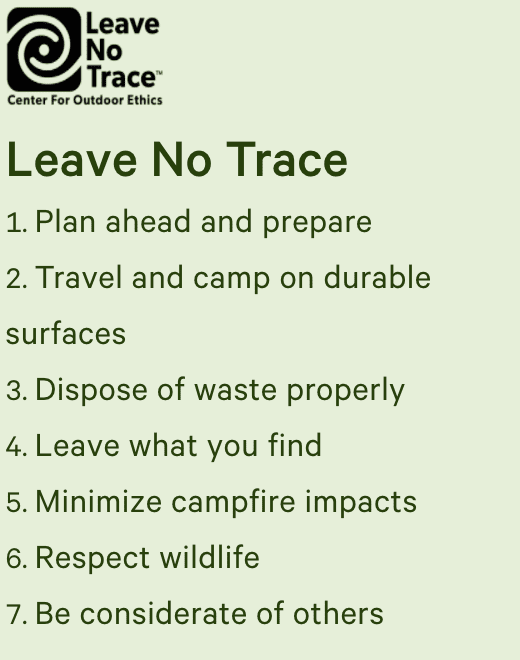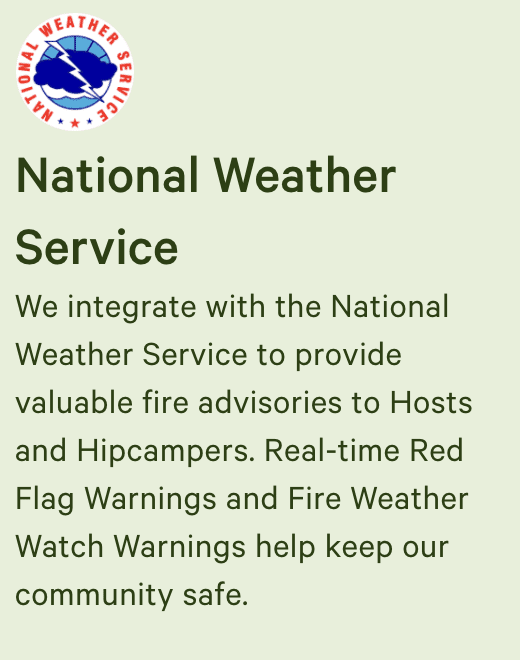River, stream, or creek camping near Panama City
White sand beaches and RV-friendly state parks make Panama City a go-to camping spot.
92% (416 reviews)
- Panama City
92% (416 reviews)
Popular camping styles for Panama City
Available this weekend
100%
(1)
Golden Retreat at Bear Creek
6 sites · Lodging, RVs, Tents7 acres · Panama City, FL
Immerse yourself in the beauty of nature at Bear Creek, an unforgettable escape. Bring your furry friends along, hook up your RV or travel trailer, and indulge in the tranquility of this well-maintained property. With WiFi and all the necessary connections available, you can enjoy a peaceful stay while staying connected.
Avoid the hustle and bustle of the city and take a short 25-minute ride to Panama City or a 40-minute ride to Panama City Beach, where you can experience the stunning beaches that have earned the title of the world's most beautiful. This is the perfect opportunity to reconnect with nature and create lasting memories.
Pets
Potable water
Toilets
from
$65
/ night
99%
(295)
"Sweet Tupelo" on the "Big River"!
3 sites · RVs, Tents12 acres · Bristol, FL
R.V. DUMP STATION for guests!
.
ALL THREE sites now have large pull-through circular driveways!
.
"SWEET TUPELO" is a magical 12-acre RIVERFRONT property offering 3 riverfront R.V. sites, spaced 150 feet apart from each other. We're directly on the Apalachicola River, approximately 15 minutes south of Bristol, Florida. These campsites have so much to offer with sweeping water views on a wide bend of the river! The campsites feature:
.
1. Waterfront R.V. camping sites spaced far enough from another camper for your enjoyment, (150 feet apart from each other with Site 1 and Site 3 having woods on one side).
2. Picnic table at EACH SITE.
3. Swivel-top charcoal grill at EACH SITE.
4. Fire Pit with wood Adirondack Chairs AT EACH SITE.
5. EACH SITE has a 30-amp and 50-amp hookup, plus 110v electric outlets, along with two city drinking water spigots, (bring your own RV electric cord and RV drinking water hose).
6. Room for boat parking
7. County-owned boat ramp, playground, restrooms, just 300 YARDS AWAY!
8. R.V. size limit recommendations: Site 1 up to 50', Site 2 up to 40', Site 3 up to 40'.
.
(For best results to see ALL features of our listing, including dates/availability of ALL 3 campsites, view our Hipcamp listing on a laptop rather than your mobile phone)
.
Our three "SWEET TUPELO" R.V. campsites are located on 12 riverfront acres in the northern Panhandle of Florida on the historic Apalachicola River. The name “Sweet Tupelo” is taken from the Tupelo tree that grows exclusively in the floodplains and sloughs along the Apalachicola River. Local bees make their honey with the pollen of these trees creating many unique health and taste benefits found only in this part of the world. When you venture back into civilization, make sure you pick up a jar of Tupelo honey. You won’t be disappointed!
.
"Sweet Tupelo" is located roughly halfway between Apalachicola and Chattahoochee, at the river's mile marker 60. This river is Florida's LARGEST by volume of water, stretching 103 miles from the FL/GA border in Chattahoochee to the historic fishing village of Apalachicola on the Gulf coast.
.
WE DO NOT OFFER RESTROOMS - You would use your RV bathroom and our RV Dump Station.
.
Quiet and respectful campers only! No loud parties allowed.
Pets
Potable water
Campfires
from
$50
/ night
97%
(234)
Maggie's Musical Farm
10 sites · RVs, Tents5 acres · Youngstown, FL
Mike & Maggie bought this beautiful property 38 years ago. Their house, The Cracker Shack, is 100 plus years old and is the second generation home of
the Gainer family who settled the Econfina area in the 1820's. It's made of heart pine and the fireplace was carved from the limestone in Econfina Creek.
Pets
Potable water
Toilets
from
$25
/ night
100%
(21)
Stay And Play The Cypress
6 sites · Tents25 acres · Vernon, FL
25acres on homes creek just a 45 minute paddle to the beauty of Cypress springs - never have to drive. Just hit the river. Cheapest canoe/ kayak rentals around.
Clean port a potty’s. And cabin rentals. All sites have a picnic table and fire pit. Grills and are on the water. Can you play corn hole in tiki bar areas. And much more see pictures
Pets
Potable water
Toilets
from
$22
/ night
50%
(4)
Lucas Lake ranch
2 sites · RVs, Tents1 acre · Chipley, FL
Almost a 1 acre property nestled in between Lucas Lake and Hicks Lake along with other small ponds and streams. There is public Lake access to Lucas Lake down the street for your boat or kayak launching. Great fishing, swimming, and wild life watching. We have 6 chickens, a cat and 1 small dog. Pets are welcomed. We are working on planting a food forest.
Pets
Potable water
Toilets
from
$30
/ night
Star Hosts in Panama City
100%
(21)
Stay And Play The Cypress
6 sites · Tents25 acres · Vernon, FL
25acres on homes creek just a 45 minute paddle to the beauty of Cypress springs - never have to drive. Just hit the river. Cheapest canoe/ kayak rentals around.
Clean port a potty’s. And cabin rentals. All sites have a picnic table and fire pit. Grills and are on the water. Can you play corn hole in tiki bar areas. And much more see pictures
Pets
Potable water
Toilets
from
$22
/ night
99%
(295)
"Sweet Tupelo" on the "Big River"!
3 sites · RVs, Tents12 acres · Bristol, FL
R.V. DUMP STATION for guests!
.
ALL THREE sites now have large pull-through circular driveways!
.
"SWEET TUPELO" is a magical 12-acre RIVERFRONT property offering 3 riverfront R.V. sites, spaced 150 feet apart from each other. We're directly on the Apalachicola River, approximately 15 minutes south of Bristol, Florida. These campsites have so much to offer with sweeping water views on a wide bend of the river! The campsites feature:
.
1. Waterfront R.V. camping sites spaced far enough from another camper for your enjoyment, (150 feet apart from each other with Site 1 and Site 3 having woods on one side).
2. Picnic table at EACH SITE.
3. Swivel-top charcoal grill at EACH SITE.
4. Fire Pit with wood Adirondack Chairs AT EACH SITE.
5. EACH SITE has a 30-amp and 50-amp hookup, plus 110v electric outlets, along with two city drinking water spigots, (bring your own RV electric cord and RV drinking water hose).
6. Room for boat parking
7. County-owned boat ramp, playground, restrooms, just 300 YARDS AWAY!
8. R.V. size limit recommendations: Site 1 up to 50', Site 2 up to 40', Site 3 up to 40'.
.
(For best results to see ALL features of our listing, including dates/availability of ALL 3 campsites, view our Hipcamp listing on a laptop rather than your mobile phone)
.
Our three "SWEET TUPELO" R.V. campsites are located on 12 riverfront acres in the northern Panhandle of Florida on the historic Apalachicola River. The name “Sweet Tupelo” is taken from the Tupelo tree that grows exclusively in the floodplains and sloughs along the Apalachicola River. Local bees make their honey with the pollen of these trees creating many unique health and taste benefits found only in this part of the world. When you venture back into civilization, make sure you pick up a jar of Tupelo honey. You won’t be disappointed!
.
"Sweet Tupelo" is located roughly halfway between Apalachicola and Chattahoochee, at the river's mile marker 60. This river is Florida's LARGEST by volume of water, stretching 103 miles from the FL/GA border in Chattahoochee to the historic fishing village of Apalachicola on the Gulf coast.
.
WE DO NOT OFFER RESTROOMS - You would use your RV bathroom and our RV Dump Station.
.
Quiet and respectful campers only! No loud parties allowed.
Pets
Potable water
Campfires
from
$50
/ night
100%
(5)
O'Neal's fish camp at Howard Creek
5 sites · RVs, Tents1 acre · Wewahitchka, FL
2 RV spots available. The larger one can accommodate up to 40' and the smaller one can accommodate up to 25'.
Step back in time and disconnect on this private, .25 acre fenced in lot, directly across from Fisherman's Landing in the secluded Howard Creek Community. Has 2 full hook up sites and both have 30 and 50 amp service. Come alone or bring a friend with their RV. Water is serviced from a private well. If you are not familiar with well water, make sure to bring your bottled water for drinking. Cell phone service is very spotty and there's no WiFi. But walk across the street to the upper landing store and they might allow you to access their WiFi. Take a short walk or drive down the road and there's good Verizon service.
RV sites are graveled and there is a fire pit avaibable. Please do NOT use the stacked wood on site. You must bring your own. PLEASE do not throw or burn garbage in pit.
Pets are allowed, but PLEASE pick up their waste.
NO GARBAGE service available. Please take your garbage with you when you leave.
Ask about monthly rates.
Pets
Potable water
Campfires
from
$50
/ night
97%
(234)
Maggie's Musical Farm
10 sites · RVs, Tents5 acres · Youngstown, FL
Mike & Maggie bought this beautiful property 38 years ago. Their house, The Cracker Shack, is 100 plus years old and is the second generation home of
the Gainer family who settled the Econfina area in the 1820's. It's made of heart pine and the fireplace was carved from the limestone in Econfina Creek.
Pets
Potable water
Toilets
from
$25
/ night
Big O Riverside Camp in Wewa
1 site · RV1 acre · Wewahitchka, FL
Private 50 amp full hook up right on the Chipola River in Wewahitchka, FL. (We do not rent the RV and please do not park on the grass)
Bring your boat! We do not have a private boat ramp, but public landings are near by. You can launch your boat and tie off on the dock, or just fish from the dock. Please be respectful of our boat that is there and do not sit or stand in it or use any of the equipment on board. There is a fish cleaning table, cooking pit, fire pit, along with 2 picnic tables. Feel free to use the shelter when needed but do not use the grills, cookers or chairs that are stored there.
Due to this being direclty on the water, we do not allow children. Please be mindful that this is a camp and we may show up to stay in our RV while you are there. And please respect our neighbors.
Pets
Potable water
Campfires
from
$50
/ night
12 top river, stream, or creek campgrounds near Panama City
100%
(21)
Stay And Play The Cypress
6 sites · Tents25 acres · Vernon, FL
25acres on homes creek just a 45 minute paddle to the beauty of Cypress springs - never have to drive. Just hit the river. Cheapest canoe/ kayak rentals around.
Clean port a potty’s. And cabin rentals. All sites have a picnic table and fire pit. Grills and are on the water. Can you play corn hole in tiki bar areas. And much more see pictures
Pets
Potable water
Toilets
Campfires
Trash
from
$22
/ night
99%
(295)
"Sweet Tupelo" on the "Big River"!
3 sites · RVs, Tents12 acres · Bristol, FL
R.V. DUMP STATION for guests!
.
ALL THREE sites now have large pull-through circular driveways!
.
"SWEET TUPELO" is a magical 12-acre RIVERFRONT property offering 3 riverfront R.V. sites, spaced 150 feet apart from each other. We're directly on the Apalachicola River, approximately 15 minutes south of Bristol, Florida. These campsites have so much to offer with sweeping water views on a wide bend of the river! The campsites feature:
.
1. Waterfront R.V. camping sites spaced far enough from another camper for your enjoyment, (150 feet apart from each other with Site 1 and Site 3 having woods on one side).
2. Picnic table at EACH SITE.
3. Swivel-top charcoal grill at EACH SITE.
4. Fire Pit with wood Adirondack Chairs AT EACH SITE.
5. EACH SITE has a 30-amp and 50-amp hookup, plus 110v electric outlets, along with two city drinking water spigots, (bring your own RV electric cord and RV drinking water hose).
6. Room for boat parking
7. County-owned boat ramp, playground, restrooms, just 300 YARDS AWAY!
8. R.V. size limit recommendations: Site 1 up to 50', Site 2 up to 40', Site 3 up to 40'.
.
(For best results to see ALL features of our listing, including dates/availability of ALL 3 campsites, view our Hipcamp listing on a laptop rather than your mobile phone)
.
Our three "SWEET TUPELO" R.V. campsites are located on 12 riverfront acres in the northern Panhandle of Florida on the historic Apalachicola River. The name “Sweet Tupelo” is taken from the Tupelo tree that grows exclusively in the floodplains and sloughs along the Apalachicola River. Local bees make their honey with the pollen of these trees creating many unique health and taste benefits found only in this part of the world. When you venture back into civilization, make sure you pick up a jar of Tupelo honey. You won’t be disappointed!
.
"Sweet Tupelo" is located roughly halfway between Apalachicola and Chattahoochee, at the river's mile marker 60. This river is Florida's LARGEST by volume of water, stretching 103 miles from the FL/GA border in Chattahoochee to the historic fishing village of Apalachicola on the Gulf coast.
.
WE DO NOT OFFER RESTROOMS - You would use your RV bathroom and our RV Dump Station.
.
Quiet and respectful campers only! No loud parties allowed.
Pets
Potable water
Campfires
Trash
from
$50
/ night
97%
(234)
Maggie's Musical Farm
10 sites · RVs, Tents5 acres · Youngstown, FL
Mike & Maggie bought this beautiful property 38 years ago. Their house, The Cracker Shack, is 100 plus years old and is the second generation home of
the Gainer family who settled the Econfina area in the 1820's. It's made of heart pine and the fireplace was carved from the limestone in Econfina Creek.
Pets
Potable water
Toilets
Campfires
Showers
from
$25
/ night
Port Saint Joe RV Resort
75 sites · RVs, Tents10 acres · Port Saint Joe, FL
For those who have visited Port St Joe before, this will be no surprise, but for those just discovering it for the first time, welcome. You have found an RV Resort that few people know about, situated on the Gulf Coast, with brand-new RV sites and modern amenities.Port Saint Joe is minutes south of Mexico Beach, without all of the crowds, and a short drive north of Indian Pass. This makes our RV park Florida’s best alternative to a Mexico Beach RV Resort or Florida’s Cape San Blas area.Sugar white sands, beautiful Florida sunshine, seafood restaurants, and stunning views of the bay make Port St Joe RV Resort the best place for monthly reservations with full hookups and cable TV.Relax on soft, white-sand dune beaches, go snorkeling on the Gulf Coast, or go fishing at a local, rustic fish shack. The local area also provides an educational and even inspirational peek into the state’s early past all from a Mexico Beach RV Resort located minutes south in the beautiful area of Port St Joe, Florida.Gift and antique stores, bistros, vest-pocket parks, vast greenways, and an appealing waterfront marina make up this tiny, easily accessible downtown. Not to mention, you have easy access to some of the best seafood in the nation!If you are looking for an RV park on the Gulf Coast that has easy access to St Joseph Bay and has fun for the whole family, there is no better place to make a reservation. Few things can beat an RV park that is situated directly south of Mexico Beach and offers an RV site you’ll love.At our Mexico Beach RV Park in Port Saint Joe, you’ll stay entertained and comfortable during your stay with Wi-Fi at your RV site and let your cares melt away. Contact us today and book your reservation!
Pets
Potable water
Toilets
Campfires
Showers
from
$55
/ night
100%
(1)
30a Paradise Pines RV Parking
1 site · RV1 acre · Santa Rosa Beach, FL
*50amp Full Hookup Site at the center of 30A and a half mile to the beach!
Discover the hidden gem of "30A Paradise Pines RV Parking," tucked away in the heart of Florida's beautiful Emerald Coast.
Just 1/2 mile from the sugar-white sandy beaches and right off the scenic 30A highway, this private, fenced spot is surrounded by peaceful woodlands, offering a perfect balance of natural serenity and accessibility.
Park your RV in our spacious site, complete with full hookups, a cozy fire pit, and a table with chairs – the perfect setting for unwinding and creating cherished memories with family and friends.
Hop on your bike and take a leisurely ride to the charming town of Seaside, where you can explore unique boutiques, admire local art, and indulge in delicious coastal cuisine. With its central location, "30A Paradise Pines RV Parking" places you right in the middle of all the action, making it easy to experience the best of the Emerald Coast at your own pace.
Whether you're looking for a quiet retreat or an exciting coastal adventure, "30A Paradise Pines RV Parking" offers the ideal setting for your next getaway in one of Florida's most enchanting destinations.
Pets
Potable water
Campfires
Trash
from
$95
/ night
50%
(4)
Lucas Lake ranch
2 sites · RVs, Tents1 acre · Chipley, FL
Almost a 1 acre property nestled in between Lucas Lake and Hicks Lake along with other small ponds and streams. There is public Lake access to Lucas Lake down the street for your boat or kayak launching. Great fishing, swimming, and wild life watching. We have 6 chickens, a cat and 1 small dog. Pets are welcomed. We are working on planting a food forest.
Pets
Potable water
Toilets
Campfires
Trash
from
$30
/ night
85%
(10)
Be Right Solutions Choctawhatchee
8 sites · RVs, Tents5 acres · Ponce De Leon, FL
5 acres right off Hwy 20 adjacent to the
Choctawhatchee River Boat Ramp near Ebro, Fl.
The bridge muffles the sound of the traffic but not enough for light sleepers.
Good views of the river.
Beautiful dock for fishing.
Less than 2 miles to Dollar General for most of your needs, 4 miles to Bruce, Fl.
Learn more about this land:
Tent camping on the Choctawhatchee River. Two public boat launches right next to the property. The boat launch has a port-a-potty as do we. We have an outdoor shower that has instant hot water.
We can accommodate boat parking on the property. We have a dock that you can tie your boat to but the water level is often not good for getting on and off the boat. I'm putting a road into the back so you can go in and out without to boat dock without crossing the road.. At present, you sometimes need a 4 wheel drive to get to the back of the property.
For those of you who wish to boondock with your trailer or motorhome, we can accommodate at most times.
There is a breakfast nook at the tiny house on the hill with a barbecue available.
Pets
Potable water
Toilets
Showers
Trash
from
$18.75
/ night
100%
(1)
Golden Retreat at Bear Creek
6 sites · Lodging, RVs, Tents7 acres · Panama City, FL
Immerse yourself in the beauty of nature at Bear Creek, an unforgettable escape. Bring your furry friends along, hook up your RV or travel trailer, and indulge in the tranquility of this well-maintained property. With WiFi and all the necessary connections available, you can enjoy a peaceful stay while staying connected.
Avoid the hustle and bustle of the city and take a short 25-minute ride to Panama City or a 40-minute ride to Panama City Beach, where you can experience the stunning beaches that have earned the title of the world's most beautiful. This is the perfect opportunity to reconnect with nature and create lasting memories.
Pets
Potable water
Toilets
Campfires
Showers
from
$65
/ night
100%
(1)
It's Creek Time
1 site · RV, Tent1 acre · Wewahitchka, FL
Approximately 1 acre of property with an area of 80x120 fenced and sitting about 80 feet off of the street, located in the eclectic little fishing community of Howard Creek. DOG FRIENDLY! You can put your boat in at the Creek landing just 5 minutes away. Howard Creek is located just 20 minutes from the St Joe Bay for saltwater fishing or access to the Gulf of Mexico, 15 minutes from the Intracoastal waterway access at White City, FL and 35 minutes from the Dead Lakes in Wewahitchka, FL.
Overall flat site partially tucked behind some trees and set back 80 feet off of the sand street. Well water hookup, septic capabilities with macerator only, electric with 30 and 50 amp at the box on the pole (approx. 100 feet from primary parking spot, depending on where you choose to park) or 30 amp at the parking spot, corner of pole barn. COLD water shower and cold water sink available. Fish cleaning station with hose. There is a pole barn on the property with our camper stored under it. You're welcome to use the remaining space under the pool barn for your leisure, approximately 20x35 ft. There's a picnic table under it, a basic food prep area with a sink, a place to put a countertop grill and a cooler. The griddle and the cooler in the photos are NOT included. Three 110 electric outlets available under pole barn. There are posts installed for shade clothes to be put up to extend the shaded area. There are 2 shade clothes there for your use. There is a fit pit on the property, bring your own wood. Be mindful of any burn bans!
We're dog people! Your dogs are welcome but must never be left out unsupervised while you're away from the property. We do have some wonderful neighbors and do not want to disturb them with excessive barking. There is a waste clean up station for your convenience, please ensure all dog waste is picked up and removed. There are dog beds under our camper and you're welcome to use them provided you care for them properly, hose them off and return them to their storage location. If your dog digs, please fill in the hole completely.
Currently a pack in pack out location. If you're staying for 3 weeks or more, we'll turn on garbage service.
There are security cameras present on the property.
This is a wonderful "Forgotten Coast" region of the Florida panhandle with so much to see and do within minutes. This resiliant area took a direct hit from Hurricane Michael in 2018 and has worked hard at recovery, with so much rebuilding and growth over the last few years.
Howard Creek is an eclectic little fishing community made up of a variety of residents from weekend fishers, summer or winter visitors and full time residents. This little golf cart community offers a small general store, a small community church, a volunteer fire department and two landings to put your boat in. They often host fishing tournaments and the occasional live music around a fire on the weekends.
Just 20 minutes from the quaint little beach town of Port Saint Joe, Florida. PSJ is known for its warm, welcoming people, old world Florida feel, dog-friendly beaches, Cape San Blas and Indian Pass. Many locally owned wonderful restaurants, bakeries and shops. It's easy to find a charter out of PSJ if you're interested in fishing! They're on Eastern Time in PSJ so don't get confused when your phones and watches bounce back and forth. If you keep driving down the coast you'll find Apalachicola just 40 minutes from our camp site. Another wonderful fishing community full of great eateries, shops and world famous for their oysters! If you leave our site and head north, you're just 35 minutes from the Dead Lakes in Wewahitchka; some gorgeous old Florida natural views and fresh water fishing; bream, large mouth bass, crappie, shellcracker and catfish.
On up the road another, just 30 minutes past Wewa and you've reached Panama City, if you're looking for the hustle and bustle of a big beach town.
Just a reminder - this is Florida and the wildlife is plentiful from snakes, birds and armadillo to alligators, raccoons and the occasional bear. Be mindful and respectful of the creatures that call this area home.
Pets
Potable water
Campfires
Showers
from
$35
/ night
99%
(36)
Wildcat Creek Educational Ctr
6 sites · Tents81 acres · Blountstown, FL
Wildcat Creek Educational Center is located on 81 acres in North Florida, we are an off the grid organic farm and educational center, teaching solar energy, permaculture, eco-construction, mushroom identification and methods for simple independent living. We have many camp sites, beds in remodeled school buses, and other sleeping structures.
Learn more about this land:
Camping, lots of spots wooded, shady, near creek or upland. 81 acres with well marked trails. Don't have with, no problem we have sleeping space in restored school buses, clean, electricity for lights, fans, cell phone charging. The Chipola river is 1.5 miles away beautiful river allows fishing, swimming, boating, kayaks available for $35 all day includes necessary equipment and transport to and from river.
Potable water
Toilets
Campfires
Showers
Cooking equipment
from
$18
/ night
Liberty Creek Getaway
2 sites · RVs, Tents5 acres · Alford, FL
Welcome to the Liberty Creek Getaway, a 5-acre parcel off our 160 acre rehabilitated timber farm that offers you a tranquil escape in the heart of Florida. Conveniently located just a short drive away from Marianna Caverns and numerous Florida cold springs, as well as close proximity to I-10 and a brief trip to the sunny shores of Panama City Beach, our farm serves as the perfect base for exploring the wonders of the Sunshine State.
Embrace the natural beauty of the area with nearby attractions such as Bear Paw Escape, Falling Waters State Park, and Hinson County Conservation. For those seeking adventure on the water, consider booking an off-shore fishing excursion to make the most of your stay.
Whether you bring your own horses to roam our expansive trails or simply enjoy watching deer, turkey and other wildlife, you'll find serenity here. We currently offer RV/tent electric hookup and ample space for tent camping, ensuring a comfortable and peaceful stay for all our guests.
Experience the charm of rural Florida at Liberty Creek Getaway, where adventure and relaxation await amidst the beauty of nature.
Pets
from
$22.50
/ night
100%
(2)
Lakes and Springs Retreat
1 site · Lodging2 acres · Miramar Beach, FL
Welcome to our little rejuvenating heaven. This is what we want to offer you, a 2.5 acres of raw nature where you can relax, rejuvenate and enjoy the best that water and nature have to offer in Northwest Florida.
You will be staying in a historic 32 ft 1954 New Moon trailer, the exact copy of the one in the movie The Long Long Trailer with Lucille Ball. Nothing less !
And don't forget to bring your kayaks, paddle boards, bikes and hiking shoes as there is a lot to do around here.
Let's start with your accommodation:
THE LONG LONG TRAILER
If you ever wanted to stay in a vintage camper with a history, then this is it. You will be staying in a 32 ft 1954 New Moon trailer. The previous owner bought it in California and claimed it was one of the trailers used in the movie with Lucille Ball called The Long Long Trailer. We like to believe that we own a piece of American culture.
The camper has water (cold only), electricity and a split ac unit. It has been partially renovated to keep the original feel and features as much as possible.
It's an old lady that survived time, so we ask that you take good care of her as well to continue the legacy.
BATHROOM - TOILET
Inside the camper, there is a small bathroom with a sink, a small tub, and a toilet but for number ones only. For hot showers and number two's you will have access to a separate shared bathroom with an indoor toilet and a spacious enclosed outdoor shower. (See pictures)
BEDROOM - BEDDING
We just replaced the mattress with a brand new queen size memory foam mattress. So far everybody likes it. We only use cotton sheets for best comfort. There are 2 nightstands on each side of the bed with lamps and cellphone charger plugs.
The bedroom has its own entrance door and a room divider can provide privacy from the rest of the camper.
KITCHEN - APPLIANCES
A comfortable kitchen area with a large sink and lots of cabinets. It's equipped with a microwave oven, toaster oven, hot water kettle and a gas stove. We also provide basic cookware, bowls and plates. Basic seasoning (good quality foods, always), paper towels, dish towels, sponges, dish soap. The cherry on the cake is the original 1954 fridge that is still working great.
CLOSET
A 2-door closet with hangers and a shelf and 3 storage compartments above the bed offer plenty of space for your clothing.
CLEANING STUFF
Basic cleaning products and gears are at your disposal inside the camper. We privilege non harsh chemical products to preserve human, animal and plant well-being.
OUTDOOR SPACE
In front of the camper you will find your own private area to chill out after a day of leisure in nature. You have a small table and 2 chairs as well as 2 comfortable armchairs. An umbrella is also provided.
YARD - FIRE PIT
We are still working on developing the property. Many parts are still undeveloped but every day we improve something. We have set up a fire pit with some lounge chairs around that you are welcome to enjoy when permitted by county regulations.
HOT TUB AND LOUNGE AREA
We just finished setting up the hot tub which is now ready to be enjoyed for an extra fee. Since it's an old model, and it is solar heated, you would have to tell us in advance the time you want to use it and we'll set it up at the right temperature for you. We allow one use per day for one hour.
We have also an area with 2 lounge chairs if you want to soak in the sun during the day.
PROPERTY ACCESS;
We live in a very rural area that you can only access by a dirt road. The roads are well maintained and regular 2WD cars are fine. If you come from I-10 / Chipley via 77, count about 3 minutes of dirt road. If you come from CR20, it's about 10 minutes of dirt road.
SPRING-FED LAKE
Our property is located on the biggest spring-fed lake in Northwest Florida - Porter Lake. We do not have a view of the lake but we are less than 2 minutes away from the boat ramp where you can swim, launch your kayaks/canoes/paddle boards, and of course your motor boat as well. Many other lakes are very close by, just minutes away. If you like fishing, then you found your perfect haven spot.
GORGEOUS EMERALD SPRINGS
We are just less than 10 minutes away from 5 of the most beautiful cold water springs on the famous Econfina creek. Each site offers a parking area, picnic settings and easy access to the springs. You can swim there and also launch your own kayaks or rent them on site.
YOUR NEIGHBORS
We live in a camper on the same property about 20 yards distant from the New Moon trailer. But you will have all the privacy you need. We also have a few full time neighbors around the property, the rest of the lake community are family vacation homes. It means that outside the holidays it is a pretty quiet neighborhood.
MORE DETAILS
Please email us if you need more information.
We hope we'll have the pleasure to welcome you soon.
Potable water
Toilets
Campfires
Showers
Trash
from
$67
/ night
Under $50
97%
(234)
Maggie's Musical Farm
10 sites · RVs, Tents5 acres · Youngstown, FL
Mike & Maggie bought this beautiful property 38 years ago. Their house, The Cracker Shack, is 100 plus years old and is the second generation home of
the Gainer family who settled the Econfina area in the 1820's. It's made of heart pine and the fireplace was carved from the limestone in Econfina Creek.
Pets
Potable water
Toilets
from
$25
/ night
85%
(10)
Be Right Solutions Choctawhatchee
8 sites · RVs, Tents5 acres · Ponce De Leon, FL
5 acres right off Hwy 20 adjacent to the
Choctawhatchee River Boat Ramp near Ebro, Fl.
The bridge muffles the sound of the traffic but not enough for light sleepers.
Good views of the river.
Beautiful dock for fishing.
Less than 2 miles to Dollar General for most of your needs, 4 miles to Bruce, Fl.
Learn more about this land:
Tent camping on the Choctawhatchee River. Two public boat launches right next to the property. The boat launch has a port-a-potty as do we. We have an outdoor shower that has instant hot water.
We can accommodate boat parking on the property. We have a dock that you can tie your boat to but the water level is often not good for getting on and off the boat. I'm putting a road into the back so you can go in and out without to boat dock without crossing the road.. At present, you sometimes need a 4 wheel drive to get to the back of the property.
For those of you who wish to boondock with your trailer or motorhome, we can accommodate at most times.
There is a breakfast nook at the tiny house on the hill with a barbecue available.
Pets
Potable water
Toilets
from
$18.75
/ night
100%
(21)
Stay And Play The Cypress
6 sites · Tents25 acres · Vernon, FL
25acres on homes creek just a 45 minute paddle to the beauty of Cypress springs - never have to drive. Just hit the river. Cheapest canoe/ kayak rentals around.
Clean port a potty’s. And cabin rentals. All sites have a picnic table and fire pit. Grills and are on the water. Can you play corn hole in tiki bar areas. And much more see pictures
Pets
Potable water
Toilets
from
$22
/ night
99%
(295)
"Sweet Tupelo" on the "Big River"!
3 sites · RVs, Tents12 acres · Bristol, FL
R.V. DUMP STATION for guests!
.
ALL THREE sites now have large pull-through circular driveways!
.
"SWEET TUPELO" is a magical 12-acre RIVERFRONT property offering 3 riverfront R.V. sites, spaced 150 feet apart from each other. We're directly on the Apalachicola River, approximately 15 minutes south of Bristol, Florida. These campsites have so much to offer with sweeping water views on a wide bend of the river! The campsites feature:
.
1. Waterfront R.V. camping sites spaced far enough from another camper for your enjoyment, (150 feet apart from each other with Site 1 and Site 3 having woods on one side).
2. Picnic table at EACH SITE.
3. Swivel-top charcoal grill at EACH SITE.
4. Fire Pit with wood Adirondack Chairs AT EACH SITE.
5. EACH SITE has a 30-amp and 50-amp hookup, plus 110v electric outlets, along with two city drinking water spigots, (bring your own RV electric cord and RV drinking water hose).
6. Room for boat parking
7. County-owned boat ramp, playground, restrooms, just 300 YARDS AWAY!
8. R.V. size limit recommendations: Site 1 up to 50', Site 2 up to 40', Site 3 up to 40'.
.
(For best results to see ALL features of our listing, including dates/availability of ALL 3 campsites, view our Hipcamp listing on a laptop rather than your mobile phone)
.
Our three "SWEET TUPELO" R.V. campsites are located on 12 riverfront acres in the northern Panhandle of Florida on the historic Apalachicola River. The name “Sweet Tupelo” is taken from the Tupelo tree that grows exclusively in the floodplains and sloughs along the Apalachicola River. Local bees make their honey with the pollen of these trees creating many unique health and taste benefits found only in this part of the world. When you venture back into civilization, make sure you pick up a jar of Tupelo honey. You won’t be disappointed!
.
"Sweet Tupelo" is located roughly halfway between Apalachicola and Chattahoochee, at the river's mile marker 60. This river is Florida's LARGEST by volume of water, stretching 103 miles from the FL/GA border in Chattahoochee to the historic fishing village of Apalachicola on the Gulf coast.
.
WE DO NOT OFFER RESTROOMS - You would use your RV bathroom and our RV Dump Station.
.
Quiet and respectful campers only! No loud parties allowed.
Pets
Potable water
Campfires
from
$50
/ night
50%
(4)
Lucas Lake ranch
2 sites · RVs, Tents1 acre · Chipley, FL
Almost a 1 acre property nestled in between Lucas Lake and Hicks Lake along with other small ponds and streams. There is public Lake access to Lucas Lake down the street for your boat or kayak launching. Great fishing, swimming, and wild life watching. We have 6 chickens, a cat and 1 small dog. Pets are welcomed. We are working on planting a food forest.
Pets
Potable water
Toilets
from
$30
/ night
Dog-friendly getaways
100%
(21)
Stay And Play The Cypress
6 sites · Tents25 acres · Vernon, FL
25acres on homes creek just a 45 minute paddle to the beauty of Cypress springs - never have to drive. Just hit the river. Cheapest canoe/ kayak rentals around.
Clean port a potty’s. And cabin rentals. All sites have a picnic table and fire pit. Grills and are on the water. Can you play corn hole in tiki bar areas. And much more see pictures
Pets
Potable water
Toilets
from
$22
/ night
Port Saint Joe RV Resort
75 sites · RVs, Tents10 acres · Port Saint Joe, FL
For those who have visited Port St Joe before, this will be no surprise, but for those just discovering it for the first time, welcome. You have found an RV Resort that few people know about, situated on the Gulf Coast, with brand-new RV sites and modern amenities.Port Saint Joe is minutes south of Mexico Beach, without all of the crowds, and a short drive north of Indian Pass. This makes our RV park Florida’s best alternative to a Mexico Beach RV Resort or Florida’s Cape San Blas area.Sugar white sands, beautiful Florida sunshine, seafood restaurants, and stunning views of the bay make Port St Joe RV Resort the best place for monthly reservations with full hookups and cable TV.Relax on soft, white-sand dune beaches, go snorkeling on the Gulf Coast, or go fishing at a local, rustic fish shack. The local area also provides an educational and even inspirational peek into the state’s early past all from a Mexico Beach RV Resort located minutes south in the beautiful area of Port St Joe, Florida.Gift and antique stores, bistros, vest-pocket parks, vast greenways, and an appealing waterfront marina make up this tiny, easily accessible downtown. Not to mention, you have easy access to some of the best seafood in the nation!If you are looking for an RV park on the Gulf Coast that has easy access to St Joseph Bay and has fun for the whole family, there is no better place to make a reservation. Few things can beat an RV park that is situated directly south of Mexico Beach and offers an RV site you’ll love.At our Mexico Beach RV Park in Port Saint Joe, you’ll stay entertained and comfortable during your stay with Wi-Fi at your RV site and let your cares melt away. Contact us today and book your reservation!
Pets
Potable water
Toilets
from
$55
/ night
99%
(295)
"Sweet Tupelo" on the "Big River"!
3 sites · RVs, Tents12 acres · Bristol, FL
R.V. DUMP STATION for guests!
.
ALL THREE sites now have large pull-through circular driveways!
.
"SWEET TUPELO" is a magical 12-acre RIVERFRONT property offering 3 riverfront R.V. sites, spaced 150 feet apart from each other. We're directly on the Apalachicola River, approximately 15 minutes south of Bristol, Florida. These campsites have so much to offer with sweeping water views on a wide bend of the river! The campsites feature:
.
1. Waterfront R.V. camping sites spaced far enough from another camper for your enjoyment, (150 feet apart from each other with Site 1 and Site 3 having woods on one side).
2. Picnic table at EACH SITE.
3. Swivel-top charcoal grill at EACH SITE.
4. Fire Pit with wood Adirondack Chairs AT EACH SITE.
5. EACH SITE has a 30-amp and 50-amp hookup, plus 110v electric outlets, along with two city drinking water spigots, (bring your own RV electric cord and RV drinking water hose).
6. Room for boat parking
7. County-owned boat ramp, playground, restrooms, just 300 YARDS AWAY!
8. R.V. size limit recommendations: Site 1 up to 50', Site 2 up to 40', Site 3 up to 40'.
.
(For best results to see ALL features of our listing, including dates/availability of ALL 3 campsites, view our Hipcamp listing on a laptop rather than your mobile phone)
.
Our three "SWEET TUPELO" R.V. campsites are located on 12 riverfront acres in the northern Panhandle of Florida on the historic Apalachicola River. The name “Sweet Tupelo” is taken from the Tupelo tree that grows exclusively in the floodplains and sloughs along the Apalachicola River. Local bees make their honey with the pollen of these trees creating many unique health and taste benefits found only in this part of the world. When you venture back into civilization, make sure you pick up a jar of Tupelo honey. You won’t be disappointed!
.
"Sweet Tupelo" is located roughly halfway between Apalachicola and Chattahoochee, at the river's mile marker 60. This river is Florida's LARGEST by volume of water, stretching 103 miles from the FL/GA border in Chattahoochee to the historic fishing village of Apalachicola on the Gulf coast.
.
WE DO NOT OFFER RESTROOMS - You would use your RV bathroom and our RV Dump Station.
.
Quiet and respectful campers only! No loud parties allowed.
Pets
Potable water
Campfires
from
$50
/ night
100%
(1)
30a Paradise Pines RV Parking
1 site · RV1 acre · Santa Rosa Beach, FL
*50amp Full Hookup Site at the center of 30A and a half mile to the beach!
Discover the hidden gem of "30A Paradise Pines RV Parking," tucked away in the heart of Florida's beautiful Emerald Coast.
Just 1/2 mile from the sugar-white sandy beaches and right off the scenic 30A highway, this private, fenced spot is surrounded by peaceful woodlands, offering a perfect balance of natural serenity and accessibility.
Park your RV in our spacious site, complete with full hookups, a cozy fire pit, and a table with chairs – the perfect setting for unwinding and creating cherished memories with family and friends.
Hop on your bike and take a leisurely ride to the charming town of Seaside, where you can explore unique boutiques, admire local art, and indulge in delicious coastal cuisine. With its central location, "30A Paradise Pines RV Parking" places you right in the middle of all the action, making it easy to experience the best of the Emerald Coast at your own pace.
Whether you're looking for a quiet retreat or an exciting coastal adventure, "30A Paradise Pines RV Parking" offers the ideal setting for your next getaway in one of Florida's most enchanting destinations.
Pets
Potable water
Campfires
from
$95
/ night
97%
(234)
Maggie's Musical Farm
10 sites · RVs, Tents5 acres · Youngstown, FL
Mike & Maggie bought this beautiful property 38 years ago. Their house, The Cracker Shack, is 100 plus years old and is the second generation home of
the Gainer family who settled the Econfina area in the 1820's. It's made of heart pine and the fireplace was carved from the limestone in Econfina Creek.
Pets
Potable water
Toilets
from
$25
/ night
Nearby parks
Explore the area’s public lands.
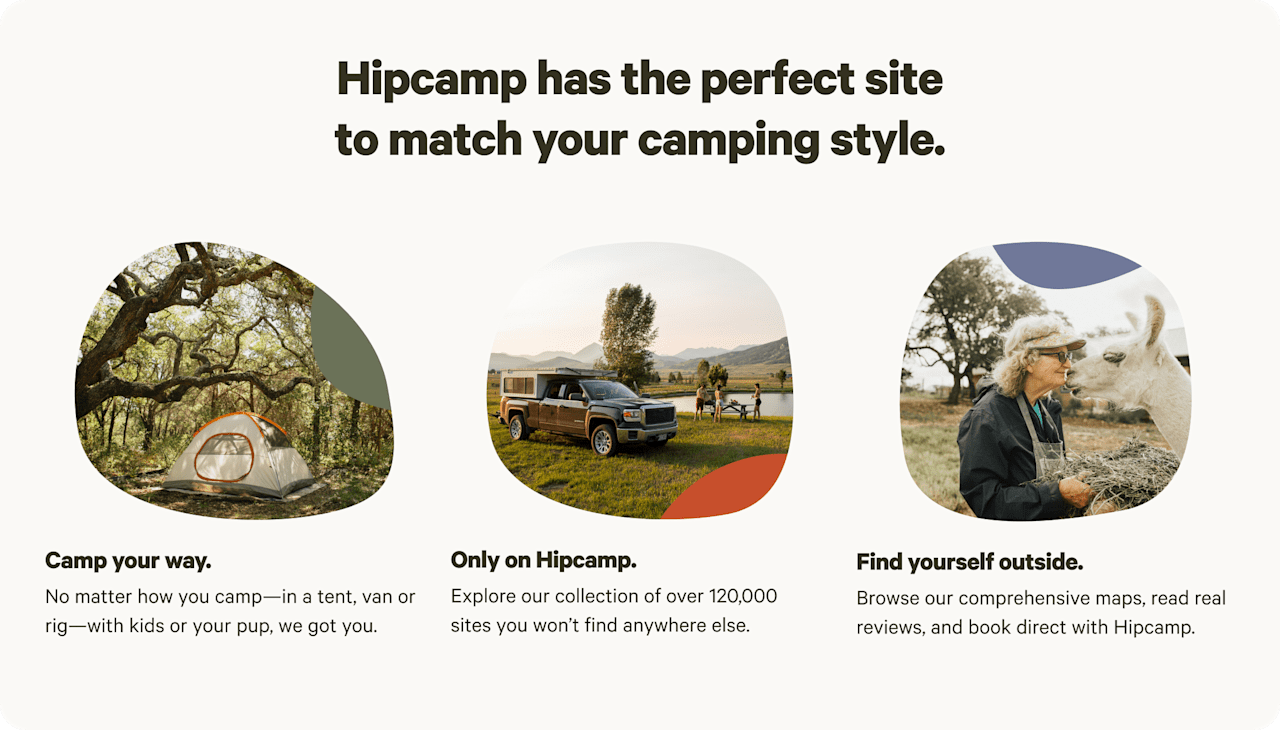

River, stream, or creek camping near Panama City guide
Overview
Looking to camp near Panama City, Florida and get your river fix? Look no further than Maggie's Musical Farm (148 reviews), Bay Forest Retreat (148 reviews), and The Wandering Path (103 reviews), you can trust that you'll have a great experience. Plus, popular amenities like pets, toilets, and campfires are available. Whether you're into paddling, surfing, or off-roading (OHV), there's something for everyone. Prices start as low as $15 per night, with an average price of $35 per night. So pack your gear and get ready for an unforgettable camping adventure!
Top cities near Panama City
Safety at Hipcamp
Hipcamp is created with ❤️ and hope for our future.
